
























































8 Navigating the Intricate Network of Trade Compliance Obligations
11 The Rise of Fintech as a Service
12 How ecommerce is transforming international express courier services
15 TechChill announces cross-ecosystem meetup in Kyiv
16 How innovation fosters inclusion
18 Volker Selle, CEO of Cheil
22 An ESG legislative minefield for multinationals
24 Why businesses need diversification to unlock resilience and stay profitable
26 A Sustainable Payment Alternative
28 How does the EU Digital Product Passport (DPP) mandate benefit businesses?
30 The EU’s New Cyber Risk Regulations Blaze a New Trail—but What Do They Mean for Businesses?
33 Edge AI software Market - Global Forecast to 2028
34 Mind Over Malware
37 Preparing Your Organisation for the Future of AI
41 Greg Wilson- CTO of Microsoft
46 The Pivotal Role of Generative AI in Cyber Security
48 Securing Tomorrow’s Business Landscape with AI and Cloud Solutions
51 Alvaro Vitta
54 Transforming Transport Operations with Mapping Intelligence
56 Designing a sustainable future: the power of collaboration in the lowcarbon metals revolution
58 A Diverging Recovery
60 The Key to Sustainable Growth
62 Why Southeast Asia is Next Expansion Frontier for European SMEs
64 How cleantech could learn a thing or two from major league rapid innovators
67 Exploring the Synergies of Next-Generation Computing and Nanotechnology
70 Green shoots are a sign global trade’s evolution is well underway
72 Essential Steps Before Investing in Cryptocurrency
76 Why Europe is catching the US in the cloud adoption race
78 “Electrification of Automotive Industry: How Electric Commercial Vehicles Are Changing the Game”
82 Attractive opportunities in the Payment Gateway Market
84 Futureproofing the Workforce in 2024
86 Dave Fishwick
88 Jim Lawless
90 Integrating Embedded Finance as a Driver of Fan Engagement
92 British retail sales to EU plunge £6bn since Brexit as clothing exports drop over 60%
Publisher Nick Staunton
Editor
Patricia Cullen
Deputy Editor
Anthony Gill
Associate Publisher Brad Adams
Features Editor Katie Winearls
Head of Production
Paul Rogers
Head of Design Vladimir Mladenovski
Subscriptions Manager
Rebecca Hill
Head of Business Development
Paul Matthews
Advertising Sales
Brad Adams Tara Duckworth
Advertising Sales
Tara Duckworth, Mike Ray, Andy Ellis, Mark Holburn
Contributing writers
Patricia Cullen, Richard Fitzpatrick, Bala Murali Krishna, Shilpa Meen, Argee Laraya, Aimee Ni Mhaolcraibhe, Gordana Ristic, Jonathan Hooker, Jose Ignacio Latorre
Head of Digital
Stephen Scott
Photographer Ben Fisher
NST Publishing Ltd, 19 Leamington Spa (studio 1) Leamington Spa,Cv324tf, UK
The information contained has been contained from sources the proprietor believes to be wholly correct however no legal liability can be accepted for any errors. No part of this publication can be reproduced without consent of the publisher.
The European Union approved a groundbreaking set of regulations to govern artificial intelligence technology. The rules will ban certain uses of AI and set strict requirements for high-risk applications like recruitment, credit scoring, and critical infrastructure. Companies violating the rules could face fines up to 6% of global revenue.

Despite interest rate hikes, inflation across the 20 countries using the euro currency rose to 7% in April, only a slight decrease from March’s 8.5% rate. Rising energy and food costs continue driving prices higher. The European Central Bank is expected to implement another rate increase in June.
A closely watched survey of German business confidence fell in May to its lowest level since the summer of 2022 as the specter of recession weighs on Europe’s largest economy. Supply chain issues and high energy costs related to the Ukraine war are amplifying growth concerns.
The European Commission proposed new rules that would enable the 27 member countries to more easily tax profits made by tech giants. Current tax policies are seen as outdated for the digital age. The proposal aims to capture revenues in countries where multinationals have users and do business, not just where firms have physical offices.
To accelerate electric vehicle adoption and meet climate targets, countries like France, Germany, and Italy are introducing new incentives and subsidies for EV purchases. Investments in charging infrastructure and battery production are also ramping up across Europe to support the transition from gas-powered engines.
The EU issued warnings that global shortages of computer chips vital for products ranging from vehicles to home appliances are likely to persist through at least 2024. Plans to boost semiconductor production in Europe with new factories and initiatives are underway but rely on substantial private investment.
With the rebound in air travel due to loosened pandemic restrictions, tourism across Mediterranean destinations like Greece, Spain, and Italy is expected to approach preCOVID levels this summer. Revenues from visitors are projected to provide an economic boost after several challenging years.

To reduce reliance on Russian energy, the EU is exploring options to revive the defunct Midcat gas pipeline project connecting Spain and Germany. This would allow Europe to tap more global supplies via Spain’s LNG terminals. However, funding questions and environmental concerns remain hurdles.

In a potential boon to European energy security, several major new oil and gas discoveries were announced in the North Sea offshore areas controlled by the UK and Norway. The finds revive production prospects in one of the world’s most mature offshore basins.
After tense negotiations, Russia agreed to extend the UN-brokered deal allowing Ukraine to safely export grain from key Black Sea ports for another 120 days. Keeping these supplies flowing is critical for global food supplies and prices amid disruptions from the war.

The European Commission filed antitrust charges against Apple, alleging the tech giant abused its control over mobile software to gain an unfair advantage over music streaming app rivals like Spotify. The case centers around Apple’s requirement for third-party apps to use its in-app payment system.
To bolster global internet infrastructure security, the EU announced plans to invest billions in undersea data cable networks connecting Europe with other world regions. The goal is to establish secure digital corridors as alternatives to cables that potentially pass through hostile territories.
German sportswear giant Adidas launched an investigation into allegations of misconduct against senior leaders after receiving anonymous complaints. Details about the nature of the complaints were limited, but the claims sent shockwaves through the company’s corporate offices.
Anheuser-Busch InBev joined the growing list of western companies exiting the Russian market, announcing it will cease production of its popular Bochkaryov beer brand in the country after 27 years. The decision was made due to logistical challenges and Russia’s “unprovoked” invasion of Ukraine.

Workers across multiple Amazon logistics sites in Germany, Spain, and France went on strike, adding to labor unrest across Europe for the e-commerce giant. Key demands include wage increases to account for soaring inflation and improvements to working conditions on warehouse and delivery jobs.

FTAs are treaties between two or more countries designed to reduce or eliminate certain barriers to trade and investment, and to facilitate stronger trade and commercial ties between participating countries.
They also directly impact a company’s supply chain and manufacturing processes, as FTAs enable the identification of efficient sourcing alternatives of raw materials and components, as well as the evaluation of target markets. It is therefore no surprise to learn that the systematic
However, of key importance is ensuring compliance with international trade regulations, which has become more challenging due to the growth of complex supply chains, the emergence of new markets and the implementation of strict regulatory frameworks. Therefore, understanding the nuances of Free Trade Agreement (FTA) rules of origin is essential to ensuring businesses make informed decisions without being penalised.
consideration of FTAs influences a company’s decision-making process about manufacturing locations and market expansion strategies, all of which contribute to the profitability of the business and the cross-border movement of goods.
A primary advantage of FTAs is the reduction or elimination of tariffs and other trade barriers. FTAs often involve the elimination or reduction of tariffs and duties on imports and exports between member countries, meaning that companies can import

raw materials and components at a lower cost, reducing the overall production cost, or lower the cost of exports for finished goods, increasing the potential for market penetration and profitability. While lower production costs can lead to increased profitability for businesses, the cost advantage can also be passed on to consumers in the form of lower prices for goods and services. Although there are many factors for this, competitive pressure and market demand are two key critical elements.
FTAs also enable organisations to enter new markets that would

In today’s globalised economy, businesses are constantly seeking ways to enhance profitability and gain a competitive edge. One powerful tool at their disposal is Free Trade Agreements (FTAs), which have become increasingly important in fostering international trade relationships.
otherwise be difficult to enter due to trade barriers. This is permitted by preferential treatment and reduced duties that increase their customer base and revenue streams.
FTA rules of origin determine a product’s origin within a trade agreement and dictate whether products qualify for preferential tariff treatment under FTAs. These rules vary between agreements due to differing objections and priorities of participating countries. FTA rules serve as a critical safeguard against non-members looking to exploit preferential tariffs established within the agreement. FTA rules of origin precisely define what constitutes local production or substantial transformation within member countries and, by doing so, ensure
that only goods meeting these criteria qualify for tariff benefits.
This stringent verification process prevents trade deflection, where non-members reroute their products through member nations to access reduced tariffs. Thus, FTA rules of origin not only protect the economic advantages intended for member countries, but also foster genuine trade among them to encourage the growth of mutually beneficial commerce and investment.
However, it must be noted that, knowingly or unknowingly, violating FTA rules of origin can lead to increased tariffs, penalties and damage to reputation — a critical aspect that is usually overlooked in international trade.
To capitalise on reduced tariffs and barriers provided by FTAs, while ensuring compliance with rules of origin, organisations can implement several strategic decisions.
First, it is crucial to assess and optimise supply chain networks to exploit lower trade costs. For instance, relocating production facilities or sourcing materials closer to FTA partners can help businesses to take advantage of tariff reductions and logistical efficiencies, reducing costs and enhancing competitiveness.
Elena Ozyman, FTA Team Lead at Descartes explains how organisations can leverage FTAs for reduced costs, increased market access and improved competitiveness, as well as understand how to comply with FTA regulations.
Second, understand market diversification factors. Expanding into FTA covered regions offers companies a compelling opportunity to tap into new markets by tailoring market-specific strategies that align with the preferences and needs of local consumers. However, this entails thorough market research to understand cultural nuances, consumer behaviours and regulatory requirements, before companies can adapt their operations accordingly.
Third, invest in research and development (R&D) with a keen awareness of FTA implications. This involves adopting a strategic approach that tightly integrates the innovation process with sourcing and production decisions. By aligning R&D with the opportunities presented by FTAs, organisations can proactively shape product innovation to capitalise on reduced tariffs and trade barriers. This entails not only creating products that resonate with the diverse preferences of FTA-covered regions but also optimising the entire supply chain to ensure seamless integration of these innovations into production. This interconnected strategy places businesses in an ideal position to maximise the benefits of FTAs, fostering agility, cost-effectiveness, and market responsiveness.
Finally, make sure you understand FTA rules of origin. A common misconception is that FTAs have uniform origin rules. Rather, each agreement is distinct, reflecting the participating countries’ specific interests and industries. The diversity of rules governing eligibility for preferential trade benefits, which includes factors such as country of origin, manufacturing processes, and value-added criteria, complicates

international trade strategies. To navigate this complexity, organisations must understand FTA-specifics, product-specific rules, and other provisions of each FTA. It also necessitates ongoing monitoring and adaptation as FTAs may evolve and rules change.
FTAs play a vital role in shaping global commerce, and their rules of origin serve as a crucial framework to safeguard trade benefits and foster genuine economic cooperation. However, it is the business’ responsibility to recognise the uniqueness of each FTA’s origin rules, stay updated with evolving regulations and tailor their
compliance efforts to each product’s specific criteria.
A trusted partner can help organisations stay informed about the governing FTA and its specifics, optimising their trade strategies and ensuring compliance with the varying rules and preferences of each agreement.
By following these essential steps, organisations can not only mitigate compliance risks but also leverage preferential tariff rates, contributing to the success and growth of their international trade operations in today’s interconnected and rapidly-evolving global business landscape.
Want to know more? Download Descartes’ FTA Guide

Fintech-as-a-Service is a fintech API (application programming interface) that allows companies—even non-financial companies—to embed financial capabilities into their existing products, services, and applications. The growth trajectory of the FaaS market is being influenced by crucial factors driving its expansion. These include the AI and Blockchain technologies fueling the drive for innovation in the business landscape. Furthermore, the growing demand for compliance and regulatory solutions has fueled the adoption of FaaS solutions, providing organizations with the expertise and support needed to mitigate risks. The increasing use of cloud computing technology has also driven the market, as organizations seek Faas solutions to meet the challenging requirements. The increasing adoption of digital payments and
the rise of e-commerce have led to a surge in demand for efficient and secure payment solutions. Additionally, the shift towards cashless transactions and the growing popularity of mobile payment platforms have further propelled the growth of the payments segment. Moreover, advancements in technology, such as real-time payments, mobile wallets, and peer-to-peer transfers, have revolutionized the way people conduct financial transactions, driving the demand for fintech solutions in the payments sector.
Blockchain provides transparency, immutability, and decentralization, making it highly appealing for fintech applications. These features are particularly beneficial in secure data storage, smart contracts, and digital identity verification. The potential cost savings, efficiency gains, and enhanced security provided by
blockchain have propelled its adoption within the fintech sector. Furthermore, blockchain technology has gained significant traction in the financial industry, especially in transactions and settlements. By leveraging blockchain, fintech companies can offer faster, more secure, and cost-effective cross-border payments, remittances, and other financial transactions. The ability to streamline and secure financial operations has contributed to the growing market size of the blockchain segment.
Blockchain eliminates the need for intermediaries in financial transactions, reducing costs and enhancing operational efficiency. This decentralized approach to financial processes appeals to businesses and consumers alike, leading to increased adoption of blockchain solutions within the FaaS market.
It is widely believed that Sting’s “Ten Summoner’s Tales” was, in 1979, the first ever item purchased online –marking the birth of ecommerce.
Today, the global ecommerce market is simply vast; in 2019, ecommerce value was estimated at $26.7 trillion, about 30% of world GDP, according to a 2021 report by UNCTAD, the United Nations Conference on Trade and Development.
But it is a fragmented, complex market; B2B, B2C, and more recently growing C2C purchases combine to create a demand on the global delivery ecosystem that today is still soaring.
There are over 5 billion people connected to the internet today. Consumers can shop anytime, from anywhere, using virtually any device, as businesses can order raw materials, components, and finished goods.
This extraordinary expansion has created a near-insatiable demand, the impacts of which are felt in every corner of the globe.
The airline industry is the key element – IATA says 80% of e-commerce goods by value travel by air.
But it’s not all driven by consumer and business demand; as express air connections are made, markets are opened and trade flows.
For example, there has been significant growth in imports from India over the last two years, largely by growing capacity at Indian airports and an increase in the number of direct links to Heathrow.
The proliferation of mobile apps and online platforms has given customers accurate tracking, real-time updates, and personalised communication - in short, much greater control and visibility over their shipments. These digital solutions streamline order placement, payment processing, and returns management - still a critical element when buying online.
Most airlines cargo handling technology remains behind developments in their passenger businesses.
General cargo products inability to easily capture and track item level data sets is problematic for ecommerce shipments where you have consolidations that contain many thousands of different items going to many hundreds of different recipients.
Capturing key data around customer preferences, speed of on and off-boarding, the online selection and ordering process, and other metrics, results in an increase in the ability to manage or influence these key measures. Only by knowing how you’re doing today can you hope to do better tomorrow.
The ability to source from literally anywhere enables organisations to optimise the balance between price, quality and choice.
- B2B ecommerce typically involves larger volumes, higher average order

Airfreight in general accounts for only around 0.5% of UK total international movements by weight but about 45% by value, according to a report by the Freight Trade Association.
There are around 70,000 domestic SME businesses online that don’t trade internationally but would like to, according to a report prepared by the Social Market Foundation, and supporting them to access global markets would be a hugely positive development both for the logistics sector and the wider UK economy.























The government has set up an ecommerce trade commission to explore how to support this, and many interested parties, including CFL, are engaging with the commission to support this ambition.









values, and longer-term contracts compared to B2C transactions.
- B2C ecommerce is facilitated by global marketplace platforms such as Amazon and Alibaba, which connect consumers with sellers and merchants from around the world.
- C2C e-commerce platforms enable individuals to buy and sell goods directly from/to other consumers. Online marketplaces, such as eBay and Craigslist, support these peerto-peer transactions.
All of this is dependent upon a fast, reliable, secure, convenient and affordable courier network that spans the globe yet reaches right





One solution could be to extend express courier facilities to other, smaller airports around the country. Cargo in and out of Heathrow is more than the sum of all other UK airports cargo shipments taken together.



Manchester or Gatwick could offer useful gateways with a dedicated courier facility – something that was actively discussed before the pandemic and may well emerge again soon.
along that famous last mile to your doorstep.
Meeting all these requirements sounds like Mission: Impossible, especially when you add in regulatory complexities, lack of cargo capacity and shortage of nighttime flying slots.
So, how do you make the seemingly-impossible possible?
In simple terms, you automate and innovate. Automation, artificial intelligence (AI), and machine learning algorithms optimise route planning, package sorting, and delivery processes, reducing transit times and costs.
Going further, a greater number of overseas facilities like those at Heathrow could create a network whereby ecommerce importers and exporters would have greater access to integrator-like services, with wider choice and greater certainty over service consistency.
However, airfreight is predicated on large consolidations that do not sit comfortably with tracking individual parcels or items – a critical requirement for ecommerce shippers. So express courier providers must develop systems to support their customers and affiliated airlines in capturing this data, to accelerate clearance, customer visibility, and support returns and duty and taxes recovery.

Cross-border ecommerce is a heady mix of B2B, B2C, and C2C transactions, combining to create an enormous global flow of raw materials, components and finished goods.
While B2B transactions traditionally dominated, the growth of B2C and C2C ecommerce has expanded the scope and scale of international commerce, creating new opportunities for businesses, consumers, and the delivery ecosystem.
Expansion of capacity and cargo flight slots will help meet the surge in demand, as will the expansion of express courier facilities around the world.
However, obstacles such as regulatory complexity, data security risks, and supply chain disruptions, create constraints within which the industry must operate. ‘twas ever thus. As ever, the answer is to innovate, and the industry is trying to find ways
by adopting and adapting technology. But the wide technology disparity across the ecommerce ecosystem has led to serious fragmentation – a situation not helped by the perpetuation of legacy systems.
We’ve come a very long way from that single, insecure, slow purchase of Sting’s album in 1979.
Matthew Ware has been CEO of CFL since 2017. He is also the chairman of Aviation Services UK, the trade body for the ground handling industry, and a member of the executive committee for AICES – the UK trade body for international express services.
Prior to his time at CFL, Matthew had 16 years with FedEx. Besides his passion for express courier logistics, Matthew enjoys his beer, coffee and wine, which are required to help him deal with his enduring but frustrating love of Tottenham Hotspur.
To those who know him well, Matthew is also known as ‘Foos’.
Created with a shareholding from across the industry, including the integrators, some airlines and handling agents, CFL has since 1983 provided a low-cost, express facility and service that has driven the growth of the courier industry at Heathrow.
CFL provides export, import and screening services for courier companies and a fully equipped facility for ground handlers and airlines. The company is a critical link between the courier industry and the airlines operating out of Heathrow.
Everything is handled within CFL’s airside facility, so all goods are security screened in-house for rapid dispatch to the aircraft.
https://cfl.aero/

TechChill announced on stage at its annual flagship event in Riga that it is going to Ukraine, and is inviting the innovations ecosystem to join. Entrepreneurs from Latvia will be driving 9 vehicles that will be donated, from Riga to Kyiv, followed by an ecosystem meetup in collaboration with Lift99 Kyiv Hub. The meetup is intended to bring together the Baltic and Ukrainian startup ecosystems – to not only demonstrate support for Ukraine, but to learn from each other and share insights. 10 Ukrainian startups will present their companies, and the Latvian delegation will present funding and growth opportunities within the Latvian startup ecosystem. The meetup will be followed by networking and refreshments.

“We are very impressed with the resilience not only of Ukraine, but also their startup community. We hope to continue to strengthen ties with the Baltic startup ecosystem to benefit both. By driving to Kiyiv we demonstrate unequivocally that we stand with Ukraine, and by bringing out startup ecosystems closer together, we highlight that we have much in common to fight for.” - Annija Mežgaile, TechChill CEO
The convoy is organized in collaboration with “Entrepreneurs for Peace”, a Latvian organization that organizes activities to strengthen the Ukrainian front through fundraising activities and car convoys. The organization has raised more than 10M EUR to date.
Latvia and the Baltic states have been staunch supporters of Ukraine, and TechChill is no exception. TechChill recently organized its flagship event in Riga, Latvia, which placed a major focus on DefenseTech and support for Ukraine. In addition to the on-stage content that has a major focus on DefenseTech, a delegation of startups from Ukraine was present, with 8 startups that were hand-selected by Ukraine’s Digital Ministry, and TechChill also held the Run for Ukraine, charity run to raise funds for drones. Through bridging the Latvian and Ukrainian ecosystems, TechChill hopes to further strengthen the two ecosystems’ ties, as well as to bolster and support the Ukrainian people, economy, and startups, through soft-power measures.
TechChill is a startup community nonprofit that hosts the largest tech event in Latvia. Having grown from a small grassroots movement of like-minded tech enthusiasts, TechChill celebrates the best of the Baltic startup community by annually bringing together thousands of attendees, including fastest-growing startups, most innovative corporations and speakers, investors active in the region and talented tech enthusiasts. TechChill is organized by a non-profit foundation of the same name, empowering the Baltic startup ecosystem throughout the year.
Media contact:
Julia Gifford julia@truesix.co +371 26100633

Financial inclusion stands as a cornerstone for societal well-being. It impacts individuals, businesses, and governments on a national scale. Recent Government reports have witnessed the steepest surge in absolute poverty in three decades. Not only that, but the Resolution Foundation reported over 11 million working-age individuals in Britain possess savings of less than £1,000, while food bank usage has soared.
Between these stark realities lies a profound issue of access to financial services. Research by PwC in 2022 disclosed that approximately 20.2 million adults in the UK were financially underserved. This deficiency in access perpetuates a vicious cycle, hindering
individuals from participating fully in the economy, saving effectively, and planning for the future.
In light of these challenges, it is imperative to view financial inclusion not merely as a matter of convenience, but as a fundamental issue of equity and opportunity. While governments bear the primary responsibility for fostering inclusive financial systems, the evolution of technology presents a promising avenue for addressing these disparities.
Embedded finance - integrating financial services into non-financial

experiences - is a quickly growing market with an ever-increasing array of use cases. One such is the issuance of digital wallets (or e-wallets) by traditionally non-financial organisations, and this is an essential part of driving better financial inclusion.
Digital wallets are an easy way to extend banking services to previously unbanked customers. People in the UK, for instance, may struggle to open a traditional bank account due to poor credit history or lack of fixed address but can use a digital wallet due to lower entry barriers. This could be part-managed by the public sector for example. By using embedded finance solutions, governments can

create digital wallets or accounts for individuals who can’t access traditional banking services.
Another area where embedded finance can play a critical role is lending. Again, many may struggle to access credit from traditional banks but may desperately need it in this current economic climate. However, if more service providers can offer credit, it may be easier to manage costs. Retailers like Iceland in the UK are exploring loan services: the Iceland Food Club offers interest-free micro-loans of up to £100 on pre-payment cards that customers pay back at £10 per week. Embedded lending technology can make it easy for other businesses to seamlessly offer similar credit
schemes to their customers and help spread out biting costs.
Embedded finance can dramatically improve access to financial services because it can be offered at the point of need and convenience. The implementation of embedded finance must be done carefully and with full compliance. As financial technology grows, regulatory frameworks are evolving to keep up, and companies looking to incorporate fintech offerings need to be aware of and abide by them.
For instance, the European Commission last summer published proposals for
the Payment Services Directive 3 (PSD3, updating PSD2) and the Payment Service Regulation. The proposals intended to improve consumer protection and security, thus levelling the playing field between banks and non-banks and fueling open banking, among others. Although the process of finalising these proposals and the Member State transition period mean there is little time before these new regulations come into force (Deloitte estimates at the end of 2026), these new regulations illustrate a sector coming under greater scrutiny and susceptible to reshaping as new payment challenges emerge.
Overseas, in November, the US Consumer Financial Protection Bureau proposed new rules to regulate Big Tech’s digital payments and smartphone wallet services. A rapidly evolving sector is an exciting space to operate in but agility is needed to adapt to the changing regulatory landscape. That’s why many organisations embracing embedded payments will collaborate with a payments partner to help them navigate shifting rules while still rolling out services at scale.
In shaping the future of finance, neobanks and other alternative providers of financial services stand at the forefront with their agile, tech-driven services and unwavering commitment to customer experience. Fintech-led digital innovations recognise the importance of facilitating financial well-being and enhance it through features like spending trackers and budgeting tools.
Embedded finance emerges as the bridge to giving customers a fair opportunity to access financial products and services from providers they trust and whom they are already engaged with. By going beyond traditional banking, the industry democratises consumer access and uplifts those marginalised from legacy systems that have underserved them.
As financial services continue their journey, inclusion must take centre stage. It’s time to embrace embedded finance as the driving force of a thrilling new era for products and services.

Join us as we sit down with Volker Selle, CEO of Cheil, the visionary leader behind the pioneering provider of connected commerce solutions. In this exclusive interview, Selle delves into how Cheil’s predictive analytics and forecasting are revolutionizing the future of retail and consumer engagement. He also shares insights into the challenges faced in this rapidly evolving industry and how Cheil is navigating and shaping the landscape of modern commerce.”
As the CEO of Cheil a leading provider of connected commerce solutions, how do you see predictive analytics and forecasting shaping the future of retail and consumer engagement?
So, starting with consumer engagement? I think it’s a very broad topic anyhow, because I think it’s a combination of a lot of stuff. Most of the companies still very much deal with the front end, even in the digital world, as well as in the physical world. And having said this, I think the engagement is driven by experience now, and I think the most important topic
is what kind of experience do you want to deliver in retail?
When I’m dealing with clients, it’s not very obvious what they really want to achieve because their needs are different now. Having for instance, a flagship store, or having a store that really should sell, is a completely different experience.
From my perspective, the ultimate experience you can have is to buy a product and take it out of the package. Behind this, there is a lot of logistic processes, and - communicating to customers, and then we dive into the topic of predictive analytics
which helps predict behaviour. And by predicting behaviour, you can predict sales and by predicting sales, it is predicting the logistic how much stock is needed.
Where are the clients or the customers and shoppers buying now, and how do you deal with the processes to create outstanding customer experience and therefore, outstanding customer engagement? To create outstanding engagement and using predictive analytics — there are hundreds of fields nowadays, where it can be applied. We are using it also to plan with field performance and operations and are using it for predicting sales. We are starting to predict shopper journeys and the experience which is needed. We are predicting how many journeys and what are the right offers if we make promotions, and predicting the price sensitivity and dynamic pricing topics.
Can you discuss in a bit more detail on how dynamic pricing strategies are evolving in today’s competitive mass market landscape and how you know, how Cheil is leveraging this approach to drive sales and customer loyalty?
One major topic is having pricing strategies and also dynamic pricing, especially when we are talking about promotions. Often there is not a deep rationale behind how you set the pricing. And most of the time, it’s very much dependent on whether you want to drive, for instance, market share by driving sales, or whether you want to drive profit.
Sometimes if you don’t use dynamic pricing in the right way maybe you drive the wrong KPI. And could lead to less profit, even though you could earn much more by having the right price point in the market. At the same time, I think it’s crucial to manage the pricing in a dynamic way regarding your competitors. If you have different competitors running a promotion in your digital world or in the retail market, then the challenge is

the performance of your promotion is going down because a competitor has set a different price point.
And that could start interfering with the sales strategy because in reality, you need to know the right pricing levels of everyone and then you have to adapt to these prices in a dynamic way. You can choose to make them cheaper, but you will need the right arguments to have a different price point, which is maybe a bit higher. Maybe loyalty members can also affect different price points.
I also think there is a wide range of opportunities on how to drive dynamic pricing into all your marketing activities now, certainly in the digital world, as well as in the physical world. We are driving us, and we have tools in place to manage this along with the predictive analytics.
How does Cheil harness data and analytics to gain deeper insights into customer behaviour and preferences?
First of all, the biggest challenge is to create holistic data, infrastructure, and data knowledge. The learning is that companies, either in their unstructured data or their data in silos, and our approach is that we have built a data infrastructure for us and for
our clients, that is able to have one data lake. And within this data lake, we can correlate all data from different touchpoints. Because I think data, pure data, has no value in way.
If data is just transforming into information, then why is it bad. But what is the implication? What is the insight behind it? Why is it like this? So, it’s a strong combination of having a holistic data approach, in combination with the right analytics, plus knowing your market and being able to interpret the data in the right way.
We also learned we should have a comprehensive set up around data, which means big data and smart data. For instance, we have a lot of big data for our clients. And we are managing all the salespeople, plus we have technical platforms in place to be able to get all the smart data from the field. Sometimes that is much more valuable than pure, big data being taken from the origin or GIF car because it helps us to interpret the data very well. I think the data framework is holistic and data framework is important. Having the right analytics, it’s still human intelligence. Everybody’s talking about AI.
Having the right combination of big data and smart data to drive the right insights. The insights are the biggest
challenge. And then if you have this, you can drive the right experience and the right engagement. Now, you can drive the right loyalty of your office shopper. Everything is more or less connected with each other. But I think you have to manage your expectations in the right way. Getting the right data set up in place, then coming to information and then pushing it. That’s a way a company has to go. But I think we have succeeded quite well with this.
How does Cheil enable brands to connect with consumers on a different level through seamless integration and what are the key benefits for brands and consumers alike?
I think this is the biggest challenge. Have you been asleep? Because in reality, we call it Omniverse or it’s like you have the physical world, then you have the digital world and then you have a virtual world connecting all these worlds. A holistic and seamless customer shopper journey of human beings is the biggest challenge. We have created a process for us, which is based on service design and business thinking. We also look at all these journeys in a very holistic approach. So that means we are not
just looking at the front end, we are looking at each of the touch points. What is the state of the shopper or consumer there? What is his emotional status? Which data do we need at this point, and which data we can grab for the next touchpoint now, to create an overall defined experience we want to achieve as a brand.
Cheil aims to be a total solution provider in the omniverse. What does this vision entail? And how does AI play a central role in achieving this objective?
It’s crucial we use AI to create a better experience on touchpoints and automate. That is the key and essential thing for us to manage the overall journey. Sometimes we can use AI to create a stronger experience, for instance, AI chatbots. This is what we’re doing for a real estate company by producing AI based content. So, it’s everything we can automate with the human touch. IN the shopper’s journey and customer journey we are using AI.
So, that means we are very much involved in the operational processes of our clients. And also, some clients are outsourcing operational work to us, which normally would never be outsourced. Now, our advantage in this case is that we really know all the problems that can occur.
Could you share examples of how Cheil has successfully implemented AI powered solutions to enhance customer engagement and drive business growth for clients?
One example is the real estate company, which is our client. Normally, they have a brick and mortar, but they also wanted to think about how to step into the digital world. So, for them, we created an AI driven platform where you can analyse millions of data points of real estate in Germany, that’s completely API driven. On the platform as well, you can compare your own real estate with its current market value. Sometimes
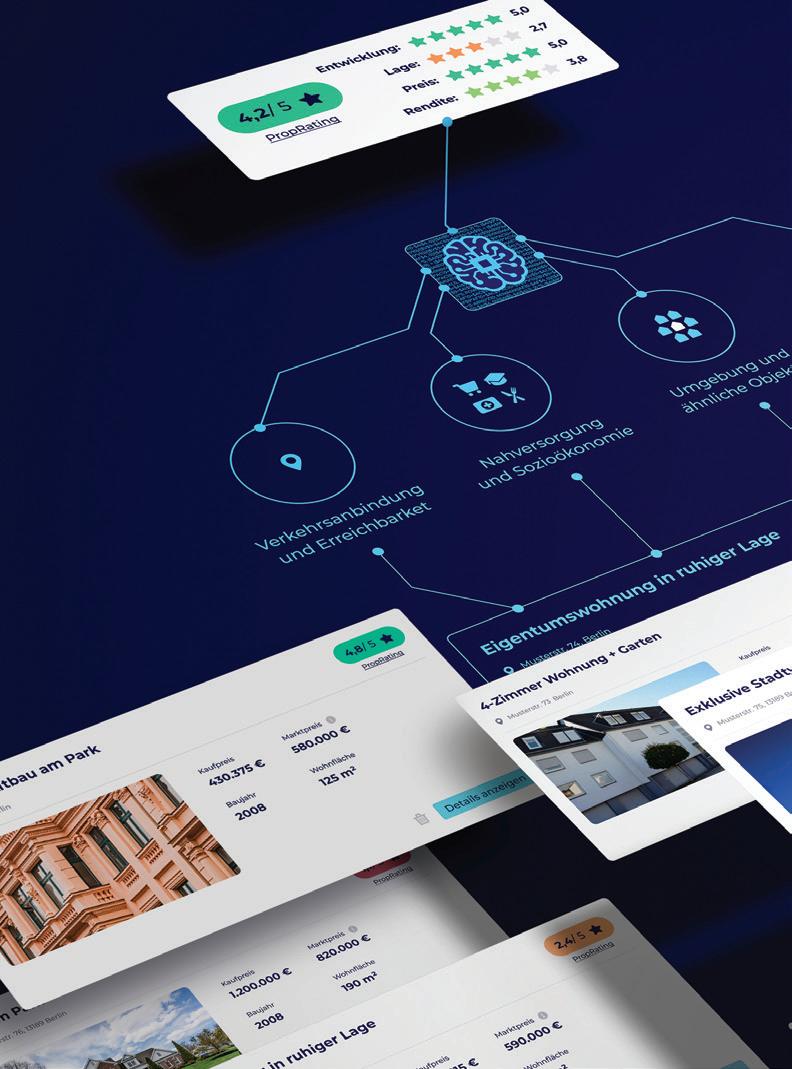
I go there for fun, because it’s like your bank account, right?
You look and see the market price, the value, and you see how much you could rent it for. It’s based on millions of data points. At the same time, we developed a content strategy where we analyse based on AI. Including the analytics on the city market situation in the biggest cities in Germany, how the developments look in the future and what the price levels are in specific regions. Normally, in the old world of advertising, a copywriter would have to spend a year
writing this data and make the presentation of it nice. Whereas now, the profiles are completely generated by AI, optimising the process.
What are the challenges that brands face in adopting AI driven technologies for consumer engagement? And how does Cheil help overcome those challenges?
I think the power of AI is that it can disrupt existing markets, for example in training this should be disrupted. We develop in smart ways, for example

a tour planning and task management tools using only AI. Those tools enable us and our clients to manage salespeople and merchandisers more efficiently — we increased visits by 145% and reduced the office time so they are out in the field. So, multitasking and all this stuff can be prioritised by AI, enabling us to develop new solutions and new tools, which can disrupt markets and make them more efficient.
First of all, it starts with knowledge, everybody is talking about AI. But the state of maturity in a lot of
companies concerning AI is average. So therefore, one challenge is to help educate and consult with other companies. This depends on how innovative an organisation is and to also help them understand AI in the right way, and not be too reluctant against new innovation, which can be difficult.
I think the Germans are famous in being very reluctant against new technology. We have the country of engineers, but we are maybe not the country of tech. There are concerns in companies now between the IT departments against AI. And there are challenges around the reliability of AI generated content. Is it right or wrong now?
We help companies first of all by helping them find the right understanding of an AI tool that can help. What is the security and context of these tools, and where are the risks and opportunities, then we help them define their guidelines on using AI. That’s very important for employees using AI tools, having guidelines and educating them on which environments they can use AI tools.
Also, it helps to start a process where you identify the topics where you can increase efficiency and effectiveness with AI. It’s interesting to have this service design approach and with this, you can then identify the processes and steps where you can use AI to make things more efficient. So, I think these are the main topic, but I think your ad should not be the sole purpose by itself, it should have a reason and a clear KPI, with what you want to achieve.
Or what do you see as the next frontier in connected commerce? And how is Cheil preparing to stay ahead of the curve in delivering innovative solutions to their clients?
So, for me, I’m German so I’m pragmatic. I study the makeup of what one topic really is. There are many topics always discussed: what happens in the future, nerds? Look at
the Metaverse, what a big discussion that was now and look at it.
My perspective is that we have to make the right foundation now. If we use the right level of technology now, the right tools — like predictive modelling pricing —then there is a clear data approach combined with AI. Most companies are far away from implementing this.
It’s shaping the future. We should really embed all these topics into connected commerce because then we really are achieving a frictionless and seamless journey of our shoppers and consumers. And that is our approach. You need agile organisation on the agency side as well as on the client side.
As you are talking about different touchpoints and silos in organisations, if you don’t have an agile platform, then you will never achieve it. And this is a huge barrier out there.
One topic that we are very much working on right now is the sustainability topic. Because there is clear data. AI is more or less clear. How to create the experience strategies is clear. Now, I think it’s about helping the clients do this work in a very sustainable way.
Where can we drive sustainability in this process? What is the level of sustainability you want to have in the physical world as well as the digital world? Because the service has an impact on sustainability — most people are forgetting this.
We really want to accelerate the transition to a resource conserving and regenerative commerce. By shaping growth through creativity, innovation and technology. That is our purpose and what we are going for. And this is what we will embed in everything we are doing in the area of connected commerce.
That is very much how I see things being done in the future. Maybe it sounds quite pragmatic. I think that it’s crucial for the future because it doesn’t make any sense to always look for the next hype. And having done the homework, it doesn’t make any sense.

 By Maria Cronin, Partner at Peters & Peters
By Maria Cronin, Partner at Peters & Peters

ESG-related legislation and regulation is an increasing focus for countries that share common climate objectives, sustainability goals and values.
Companies with international operations face complex ESG-related challenges and potential exposure across multiple jurisdictions. This means that those companies must adapt their business practices and models to comply with the developing rules and regulations in the various countries in which they operate. ESG-related legislation and regulations are increasingly targeting all types of business
model and supply chain, presenting an all-encompassing task for multinational organisations.
There is no singular ESG-edict. This is perhaps unsurprising given the impact of different markets, practices, and the level of variability across different jurisdictions in the political will to achieve climate objectives. As a result, there is no one size fits all solution for organisations when it comes to ESG compliance.
Multinational companies must therefore give careful consideration to ensuring that they are compliant with this diverse and growing set of rules and regulations. Thomson Reuters recently reported that 71% of C-Suite and functional leaders anticipate the growing significance of ESG in
corporate performance, with one executive commenting that there were “close to 40 regulations on their radar.”1
As well as the volume of new rules and requirements, organisations also face challenges relating to the clarity of the legislation (or lack thereof), and divergences in approach and guidance between different jurisdictions. For example, the new EU Deforestation Regulation requires companies that trade in seven common commodities (e.g. coffee, cattle, and wood) and multiple derived products to comply with local ESG laws (in country of production) and to follow a prescribed method of transparency with respect to due diligence. Failure do so, or if a product is not ‘deforestation free’, will preclude that product from being sold

1 ‘The 2023 State of Corporate ESG: A the crossroads of data, regulations, and digital solutions’, Thomson Reuters Institute, Report, published November 2023. Link here.
in the EU. Ensuring compliance with this Regulation, including adhering to local ESG laws potentially across multiple jurisdictions, is likely to impact business operations, resource allocation and profits.

Not only are multinationals juggling the interpretation and implementation of ESG-legislation across geographies and jurisdictions, they are also having to manage the overriding conflicting political agendas surrounding ESG. While some countries have climate-related incentives and subsidies for businesses, other countries are slower to implement similar advantages. A change at the ballot box or a sudden political U-turn could either hasten or dampen the rate of progress for businesses in respect of ESG-related policy changes.
By way of example, the U.S. Inflation Reduction Act has committed approximately US$400 billion in subsidies
over the next 10 years for business investment into green technologies, with the additional aim of creating jobs and boosting the US economy. Conversely, in March 2023, Republican governors from 19 federal states issued a statement calling for the prioritisation of shareholder profits over ESG ideologies. In May 2023, Florida enacted ‘anti-ESG’ legislation, which seeks to drive rates of return by pushing decision-makers to consider financial factors over ESG-related factors, when making business decisions, and non-preferential status for ESG-compliant organisations in the procurement and contracting process.
The political differences with respect to ESG are also visible in Europe. For example, whilst the EU Corporate Sustainability Due Diligence Directive was approved by the EU last month, the final version of the Directive was greatly reduced in scope compared to its initial draft to satisfy concerns of member states. The Directive, which still needs to be approved by the European parliament before it comes into force, will provide a minimum set of due diligence requirements and will establish a framework for complainants to sue EU companies for human rights abuses and environmental harm in their supply chains.
Multinationals also face hurdles from shareholder and climate activism. There has been a significant uptick in claims brought by minority shareholders and NGOs for failure to address ESG-related risks and climate change objectives, particularly where state enforcement has been markedly absent. This has forced companies to adopt new ways of operating and also to assessing ESG related risk.
As a result of this rapidly changing landscape, multinationals and smaller companies are investing proactively in internal and third-party solutions to stay abreast of their regulatory requirements. This includes
conducting internal investigations into vendors and suppliers, collecting data, and contracting with consultants to improve business operations in an ESG context. Data-driven changes are becoming increasingly reliant on AI and analytics.
Some multinationals are focussed on compliance with existing regulation as it comes into effect, whilst others may be mindful of potential ESG issues at the start of business expansion and implementing ESG-ideologies before any overarching legislation is in place. This could, however, put these companies at a competitive disadvantage if ESG reforms do not come into effect until much later down the line.
Adaptability of multinationals is key to navigating ESG risks. The need to grapple with ever-changing legislation imposed on the context of international business models, in the shifting sands of political attitudes and geopolitical strains increases the operational risk to multinational companies and is forcing them to consider how best to monitor, comply and report on their ESG performance.
Where subsidies are insufficient or non-existent, stringent ESG requirements may deter companies from taking the leap to international expansion. Companies may need to choose between the ethical considerations of adhering to ESG ideals and opting to operate in anti-ESG jurisdictions to maximise profit. A decision that will no doubt be influenced by shareholder and investor pressure.
Will there be anti-ESG jurisdictions, where multinationals or smaller companies positively choose to operate and manufacture, much like certain benefits that come with operating offshore bank accounts? This does not circumvent their potential inability to expand and trade within certain markets, depending on the product, but that may be a price that they are willing to pay.
Each multinational must work to find tailored solutions that work for their business model and operations – there is no cookie-cutter way of doing this.
 By Jan Sedlacek, Co-founder and Managing Partner at Stryber
By Jan Sedlacek, Co-founder and Managing Partner at Stryber

In 2024, the M&A market is projected to undergo significant changes – with many anticipating an increase in deals will likely be slower compared to the rapid activity seen in late 2020 and the record-setting year of 2021; meaning businesses will need to adjust their strategies accordingly.
Although credit markets have reopened, borrowing money is more expensive than it was previously. This will lead to lower valuations and require businesses to generate more value to achieve the same returns as
before. With ongoing uncertainty in the wider economy and geopolitics, businesses which can assess risks and plan for various situations will feel more confident in making decisions compared to those that wait for clearer signals.
Companies should therefore take the current market environment as a chance to diversify from their core business model to secure sustainable growth. It’s a great opportunity to create new sources of revenue by capitalising on low valuations for acquisitions and the entrepreneurial talent
available on the market due to the decrease of financing in the venture capital space.
At Stryber, we recently issued our Diversification Dividend report, which analysed 738 listed companies across Europe to assess how total shareholder return developed over the turbulent COVID years and beyond. It showed that stocks from diversifying companies delivered 53% higher annualised shareholder returns in that time period. However, a staggering 70% of companies fail at doing so, which means Superdry, which

recently delisted from the London Stock Exchange due to failing to keep up with trends and adapt to changing markets, is in good company, unfortunately.
There is a well-established theory from the world of finance, which has been empirically proven many times over, called Modern Portfolio Theory. It formalises the concept of ‘don’t put all your eggs in one basket’ - which translates to, when we are looking to invest money, we shouldn’t plunge all our wealth and life savings into one stock.
We can apply the same hypothesis here for companies – ensuring you hold different businesses with various sources of value and income streams, will drive success in differing market environments. While your
primary revenue driver should be a strong platform to build from and provide funds to create new revenue streams, it usually will not sustain itself indefinitely.
Top performing companies are those seeking opportunities and securing new revenue streams through Mergers & Acquisitions or building new business models, which reward them with a higher total shareholder return. It clearly shows that diversification is not only a strategy for growth but also a hedge against market volatility. Those businesses are better positioned to weather economic uncertainty and deliver long-term success.
The pandemic further accelerated significant change in how businesses operate - whether through the use of emerging technologies or adopting new hybrid and remote working practices. Looking at the total shareholder revenue of businesses during this time, there is a clear outcome separating the ‘winners’ from the ‘losers’.
As an example, the most prominent collapse of businesses we saw during the pandemic was within the travel and tourism sector. As lockdowns tightened, air traffic plummeted by nearly 40%, resulting in the collapse of 64 airlines. Predictably, this downturn created a profitability vacuum, dragging auxiliary services like car rental giant Hertz into bankruptcy as well. Businesses which were overly reliant on in-person revenue streams similarly toppled like dominos. WeWork became obsolete with the surge of remote work, and in a similar vein, traditional fitness centres like Golds Gym lagged behind as home fitness equipment such as Peloton bikes gained popularity.
This created an urgency for businesses to adapt, in order to weather the economic storm of the pandemic. The question was whether they will be able to. Our research showed that adaptability comes down to the capability to diversify. If your planes are grounded, the best way to adapt to the situation is to have businesses that are not grounded. A great example
of a business diversifying in order to buffer against the torrent of economic uncertainty during the pandemic, can be found with Swedish companies, Husqvarna and Indutrade.
Husqvarna, established in 1689, shifted from making guns to producing outdoor power products, with divisions in gardening, watering systems, and construction. When the pandemic hit, its construction division suffered, but the other two divisions saw increased sales due to people spending more time gardening during lockdown. The CEO Pavel Hajman credits the businesses success to constant reinvention and seizing market opportunities.
Indutrade, on the other hand, weathered the market shock by being a conglomerate built through acquisitionsachieving a 4% growth in sales and a 12% higher EBITDA margin compared to 2019. The company’s CEO, Bo Annvik, highlighted its strategy of diversification, with the business having over 200 companies in various sectors and geographic markets, which reduced the company’s reliance on any single segment or market.
However, the presence of both successful and unsuccessful instances underscores the importance of diversification. Occasionally, misguided efforts towards diversification can result in stagnation of growth and significant underperformance in total shareholder return. This emphasises the need for strategic expertise, appropriate governance, and adept planning, to steer revenue diversification effectively.
A lack of diversification altogether poses a significant risk to shareholder value. It is crucial for ensuring sustained success, particularly when businesses find themselves in uncertain circumstances. While some fledgling companies may struggle due to their age, established firms face a distinct challenge: a lack of organisational ability to execute diversification strategies effectively. Overcoming this obstacle is imperative for businesses, as it prevents their ability to reap the benefits diversification can provide.
 By Brad Hyett, CEO of phos
By Brad Hyett, CEO of phos

Cash, despite its familiarity, carries hidden environmental costs. Paper production, plastic waste, and the logistical resources associated with cash contribute to a substantial ecological footprint. A 2020 study by the University of Leeds revealed that the annual carbon footprint of cash in the UK alone is equivalent to driving a car 2.1 billion kilometres - an alarming finding that highlights the urgent need for more sustainable payment solutions.
This environmental impact coincides with a growing consumer preference for sustainable practices. According to a Deloitte survey, Millennials and Gen Z are more concerned about climate change than any other cause.
With Gen Z set to become the largest generation of consumers, businesses are increasingly seeking solutions that align with their customers’ values.
Software Point-of-Sale (SoftPoS) technology offers a powerful answer: secure contactless payments leveraging existing smartphones and tablets. It transcends its role as a convenient payment solution, promoting a cashless environment while paving the way for a more sustainable future.
Cash-in-transit services and physical point-of-sale terminal production contribute to greenhouse gas emissions. Payment methods continually evolve,
with technology and innovation striving to maintain high customer satisfaction while combating climate change. A prime example is SoftPoS adoption, which reduces reliance on cash services, minimising the carbon footprint within the payment ecosystem.
The way SoftPoS leverages existing devices, eliminating the need for additional hardware production and disposal, is a major advantage of the technology from a sustainability perspective. It reduces the environmental impact associated with plastics, silicon production, and the logistics of device manufacturing and delivery. By slashing the carbon footprint of the payments ecosystem and decreasing the environmental hazards associated

with electronic waste, SoftPoS positions itself as a sustainable payment method for businesses of all sizes.
SoftPoS is a digital-first approach that eliminates the need for paper receipts and physical cash. This translates to a significant reduction in resource extraction, production, and transportation associated with paper currency. Adoption of such technologies can significantly reduce paper waste associated with traditional payment methods, with a widespread shift to digital payments having a significant impact on the environment.
Beyond environmental benefits, SoftPoS fosters enhanced efficiency for businesses. Streamlined digital transactions empower businesses with better data insights and analytics, enabling them to optimise inventory management, resource allocation, and overall operational efficiency. Reduced reliance on cash handling also translates to faster transaction times and shorter queues, improving the customer experience while reducing stress on workforces.
By embracing SoftPoS, businesses can demonstrably contribute to a more
sustainable future. Reduced paper waste, streamlined operations, and a greener supply chain all lead to a smaller environmental footprint. Moreover, offering a frictionless payment experience aligns with the growing preference of environmentally conscious consumers.
SoftPoS is more than just a payment solution; it’s a strategic decision for businesses seeking to operate sustainably and competitively in the years to come. Embracing SoftPoS isn’t just adopting a technology - it’s a decision to future-proof your business. By transitioning towards a cashless future, businesses can shape a more sustainable world while meeting the evolving needs of their customers.

Sustainability has become a business imperative. Over time and across multiple sectors there has been a growing concern over the amount of waste produced when products reach end-of-life, and the carbon footprint of products as they move through the value chain.
The EU has also taken note, and is putting tangible steps in place to support the creation of a circular economy. A big part of this is the Ecodesign for Sustainable Products Regulation (ESPR) - part of the Circular Economy Action Plan (CEAP). The ESPR is a published framework that will set
the design requirements of products to ensure their sustainability.
Under the upcoming regulations, many products that are manufactured or sold within the EU will need to include a Digital Product Passport (DPP) – a tool for collecting product data throughout a product’s life cycle. The aim is to encourage manufacturers and supply chain managers to adopt more sustainable practices and encourage end-users to be more mindful of the sustainability and authenticity of the products they’re purchasing. The mandate will apply
to numerous product groups across multiple industries that place products on the EU market - regardless of whether or not they were produced there - it will apply to a broad range of businesses, with priority industries expected to be compliant by 2030.
With the help of DPPs, this regulation aims to make “sustainable products the new norm in the EU, by making them last longer, use energy and resources more efficiently, easier to repair and recycle, contain fewer substances of concern and include more recycled content.”

Digital Product Passports (DPPs) essentially act as a “digital twin” of a product, by capturing information related to a product’s entire lifecycle. This can include anything from the materials that were used to create it, the environmental impact of the product, ownership, how to responsibly dispose of the item, and important information on warranty or maintenance. This information is typically accessed through a data carrier like a QR code or barcode, with information

being accessed by a device such as a smartphone.
The reason they are an important part of the circularity aim is because DPPs can help prove that the materials used in their supply chain were sourced sustainability, and ethically, and also help all parties in the value chain access information to make choices that contribute to the sustainability effort.
While DPPs are being seen as the perfect tool to support the EU’s effort towards circularity, they also open up a new direct channel for brands to engage directly with customers and foster more loyalty.
For example - if we stay on the topic of sustainability - DPPs help businesses to prove the sustainability credentials of their products to the end consumer and not simply “greenwashing”. By tracking previous ownership, verifying authenticity and keeping a history of any repairs made to a product, businesses could begin a verified resale scheme, encouraging users to recycle their products, turning them back into usable products to be resold - another effort towards the circular economy and proving that sustainability is important to a customer base.
Furthermore, for products that can be added to or form part of a collection, complementary products could be recommended to customers within the DPP and compatibility checked; helping maintain contact and create return customers. DPPs could even be integrated with existing loyalty platforms or used to provide rewards in the future so that customers are compelled to engage with the brand more.
In more complex implementations, information gathered from DPPs could even help inform measurement of sales trends and metrics, helping these businesses to better track their stock, plan for sales events, and better understand the needs of their customer base.
The EU’s mandate will undoubtedly impact many businesses, but the way each business takes hold of the challenge will dictate whether they simply comply, or comply and thrive. For businesses starting from scratch now, the best first step is to assign a DPP lead or a team to spearhead the efforts towards compliance, and their first priority should be to aim to understand everything they can about the regulation today, and what will be defined in the near future. Success will come to those businesses who plan earlier and see the vast potential.
 By Nick Kathmann, CISO, LogicGate
By Nick Kathmann, CISO, LogicGate
While other jurisdictions grapple with the rise of AI and the emergence of new cybersecurity challenges, the European Union (EU) has sprung into action with a series of new regulations aimed at limiting digital risk. The EU AI Act, EU Cyber Resilience Act, and EU Digital Operational Resilience Act (DORA) each represent a new chapter in governing cyber risk—but what do they actually mean for businesses? Will your organization be impacted by the new rules? What about your partners or suppliers? Understanding what these new guidelines are intended to achieve is important, but it is equally important to

understand what the real-world impact will be on organizations and how they will affect governance, risk, security and compliance (GRC) operations moving forward.
Let’s start with the EU Artificial Intelligence Act, which was officially adopted on March 13, 2024, and should enter enforcement within the next two years. The EU AI Act represents the first comprehensive framework developed by the EU to help govern the use and development of AI. As you
might guess from its name, the regulation is not global in nature—it is specifically aimed at the EU—but it does have global implications. Whether or not they are headquartered in the EU, organizations doing business within the EU will need to be sure they are maintaining compliance with the EU AI Act, which means it will impact just about every multinational corporation.
AI and machine learning have been around for a long time. Even before the advent of what we consider “modern” AI, spam filters were using supervised models to block spam emails from cybercriminals. (Ever received an email promising

“FR33 P!LLS”? These were eventually blocked by one of these early models.) We’ve obviously come a long way since then, and generative AI is becoming both more advanced and increasingly accessible as AI developers dedicate significant sums of money to the technology. According to OpenAI, building and training ChatGPT 4 cost more than $100 million, while Google spent nearly $200 million developing its Gemini tool. Organizations are devoting a lot of resources to making these solutions even bigger and better as time goes on.
But with any new technology comes risk—and the EU AI Act aims to help
address that. The new legislation establishes four risk-based classifications for how AI is used and developed, with different safety and security requirements for each risk level. Industries like critical infrastructure or law enforcement fall under a “high-risk” classification, which carries a lengthy list of requirements that AI developers doing business with those industries will need to meet. These might include data storage and record keeping mandates, market surveillance demands, transparency standards, and other requirements. Each one is tied to significant financial penalties that range up to 6% of the company’s total worldwide annual revenue—a tidy sum.
The practical implications here are serious. There is a lot of AI-based innovation happening within the EU (and in countries that do business with the EU), and these new regulations include substantial due diligence requirements, adding to the already onerous number of regulatory guidelines and frameworks businesses need to keep track of. While it’s a definite positive that the EU AI Act applies to the entirety of the EU, the growing number of AI regulations in countries around the world (and, in the case of the U.S., individual states) has created a difficult web of frameworks—many of which contradict each other. A lot of organizations will need to rethink how they manage the risk and compliance aspect of AI—in fact, it won’t be surprising if GRC soon becomes “GRCAI.”
In addition to the EU AI Act, the EU Cyber Resilience Act was also approved by the European Parliament in March. Rather than specifically targeting AI, this act is aimed at connected devices and the software that runs on them—ranging from smartphones and laptops to smart fridges and washing machines. In today’s
increasingly interconnected world, anything connected to the internet represents a potential attack vector, and bad actors will target connected devices and use them as a jumping-off point into other systems, networks, and organizations. Some of the biggest DDoS attacks in history (such as the Mirai Botnet) have originated from devices like home routers. The fact that these devices are connected directly to the internet, rather than sitting behind corporate firewalls, makes them particularly vulnerable.
Not so long ago, these connected devices were easy to secure. They ran on an assembly loop and would simply reboot and reset if something abnormal was detected. Now, these same devices use higher-order languages, often with full Linux (or even Windows) systems running natively. Instead of a simple loop, they now have millions of lines of code and a wide range of code libraries that attackers can target. But perhaps the biggest problem is the lack of support many of these products receive. A connected device might receive 12 to 18 months of support before the manufacturer moves on to the next thing. This is understandable, but it leaves those devices no longer receiving updates or patches vulnerable to attack.
EU Cyber Resilience Act effectively mandates that companies support their products for a longer period of time—and ensure that consumers know how long they can expect that support. They need to make it known how they plan to secure those devices, and also implement new vulnerability management solutions. When a vulnerability is identified, the manufacturer needs to acknowledge it and submit a plan to address it within a certain amount of time. The idea is to add new consumer protections that reduce the number of attack vectors adversaries can use to target connected devices. Like the EU AI Act, these new rules come with serious penalties—up to $15 million or 2.5% of total annual revenue (whichever is higher).

The EU Digital Operational Resilience Act (DORA) is also focused on cybersecurity, but sets its sights specifically on risk management (including third-party risk management) and incident response/reporting in the financial industry. The new law will go into effect next year, with the goal of helping banks and other financial institutions protect themselves from attacks and improve their resiliency in the event of a breach. It’s easy to see why this would be of interest to regulators: when a financial institution suffers a cyberattack, it has downstream effects impacting nearly every other industry. When businesses (or individuals, for that matter) can’t process payments, access accounts, or use their banking platforms, it can grind the economy to a half. In fact, modern cybercriminals may not even need to target a bank: they can often accomplish the same result by attacking a trading platform or other third-party service.
As a result, DORA doesn’t just apply to financial institutions themselves. It applies to financial firms, crypto platforms, cloud service providers, risk management services, and dozens of other industries that meaningfully interact with the finance industry. The law establishes a new risk management framework around which these businesses need to build, similar to frameworks like NIST that American businesses may already be familiar with. It establishes basic guidelines around threat detection, prevention, and response, as well as a mandated reporting period when an incident does take place.
DORA also mandates a certain degree of digital operational resilience testing. Organizations need to be able to demonstrate sufficient business continuity capabilities in order to establish that a single cyber incident cannot adversely impact the broader financial industry. If the entire company goes down, what will they do? How will they get back online, and in what order? How do they inform
customers before the breach is made public? The ability to plan for the worst is critical. The framework also establishes procedures for sharing cyber threat intelligence. The U.S. has a similar initiative, known as FBI InfraGard, which helps push companies toward intelligence sharing for the benefit of all.
Perhaps the most important takeaway here is the fact that the legislation will impact such a wide range of companies. Any business considered a “critical third party” to the EU companies that fall under the financial services umbrella will need to be sure they are in compliance with DORA, or risk not being able to do business with EU-based businesses. For now, organizations will need to judge for themselves whether they fall under this rule, but as implementation gets closer, critical third parties will likely be informed by their partners and customers that they need to maintain DORA compliance or risk losing their business.
That the EU is leading the way when it comes to establishing AI guardrails and risk awareness regulations should come as little surprise— after all, the EU also paved the way for new data privacy rules when it passed the General Data Protection Regulation (GDPR). Rest assured, these EU guidelines are only the beginning—in fact, the U.K. is already in the process of implementing its own Corporate Governance Code and Operational Resilience framework, underscoring the fact that this regulatory trend is likely to spread quickly. But the truth is that establishing strong data governance capabilities and effectively managing cyber risk is a good idea for every organization - and customers - and these new regulations should serve as motivation for businesses across the globe to take the necessary steps to improve their GRC (or should I say GRCAI) capabilities.

Edge AI combines two emergent technologies: edge computing and artificial intelligence (AI). Whereas edge computing stems from the same general premise, in that data is generated, collected, stored, processed, and managed from a local location rather than a remote data center, edge AI further evolves the concept to the device level, using machine learning (ML) that mimics human reasoning to reach points of user interaction, such as a computer, edge server, or Internet of Things (IoT) device. In general, these devices don’t require an Internet connection to operate and can make decisions independently
The global market for Edge Al Software is projected to grow from USD 1.1 billion in 2023 to USD 4.1 billion by 2028, at a CAGR of 30.5% during the forecast
period. Edge AI software is revolutionizing industries worldwide, driven by its ability to process data in real-time, minimize latency, and bolster security. This exponential growth can be attributed to several factors, including the proliferation of IoT devices generating massive amounts of data that require real-time processing. Edge AI software effectively addresses this need by analyzing data on the edge, eliminating the need for cloud transmission. Additionally, edge AI software reduces latency by processing data closer to the source, ensuring real-time responses critical for applications such as autonomous vehicles and smart cities. Furthermore, it enhances security by isolating data on the edge, making it more resistant to unauthorized access.
Edge AI software is being adopted in the healthcare and life sciences vertical to enable smart medical facilities with digital diagnosis and remote patient monitoring. The adoption of Edge AI in healthcare is critical for both patients and healthcare providers, as it can automate tasks, enable autonomous monitoring of hospital rooms and patients, and monitor vital signs. Edge AI computing usage cases can greatly extend the range of health services, and large chip manufacturers have been investing heavily in Edge AI. Edge AI is utilized for in-hospital patient monitoring, fall detection, radiology, and anomaly and injury detection. Real-time insights and alerts can be given to operators as suspicious activity or objects are detected.

AI and cloud technologies hold the potential to boost the UK economy by over £550 billion by 2035, promising to increase productivity, enhance skills, reduce waste, accelerate scientific innovation and create new products and services.
AI enables companies to automate processes, improve efficiencies, and deliver personalized experiences, fueling growth and competitiveness in today’s market.
However there is another side to the coin. As technology progresses, malicious actors are also focusing on AI, and reaping its benefits.
According to the UK’s National Cyber Security Centre (NCSC), the technology will “heighten the global ransomware threat” and “almost certainly increase the volume and impact of cyber-attacks in the next two years.”
AI-driven cyber-attacks have become the new standard, leading to approximately 20 major breaches, and counting, across North America, Europe and Japan already this year, underscoring the urgent need for businesses to adopt robust cybersecurity measures.
Furthermore, the 2024 report on Cybersecurity Trends, Obstacles, and Opportunities found that ransomware and AI-generated attacks are a huge concern for cybersecurity leaders. Almost 40% of those surveyed said they

are resilient to cyberattacks, with 48% deemed vulnerable and the remaining 39% facing high risk. These are worrying percentages considering cybercrime will cost the global economy up to $10.5 trillion by 2025.
The report also revealed that organisations that use AI-enabled cybersecurity are twice as resilient to attacks than those that don’t and suffer 20% less costs when attacked. By harnessing AI tools such as machine learning, businesses can defend against malicious threats, outmaneuvering attackers and outsmarting them.
The findings emphasize the urgent need for businesses to prioritize investment in AI-driven security solutions to bolster their defenses and mitigate the growing risks posed by cyber threats.
With the introduction of ChatGPT 4 last year, how will the increasing integration of AI in workplaces impact the ongoing battle against cybercrime?
More and more companies are realizing the effectiveness of AI-driven solutions in safeguarding against cyber-attacks. Giants like Microsoft, Google, and Amazon have already adopted these solutions, employing methods to automatically identify threats and respond to them through automated systems detecting suspicious network activity.
In response to heightened danger, the government has also allocated £2.6 billion as part of its Cyber Security Strategy to bolster the UK’s defenses. Both the NCSC and private sector have embraced the integration of AI to bolster cyber security resilience by enhancing threat identification and implementing security measures.
were spending more money on cyber defenses because of these problems. It’s vital for organizations to always be one step ahead of new threats by dedicating significant resources to strengthening their defenses, ensuring they remain resilient in the face of evolving cybersecurity challenges.
The percentages don’t paint a pretty picture. A report from Microsoft and Goldsmiths, University of London, ‘Mission Critical: Unlocking the UK AI Opportunity Through Cybersecurity’, found that just 13% of UK businesses
AI isn’t solely fueling the proliferation of scams; it’s also empowering businesses with innovative tools to combat them. To counter the threats posed by malicious actors, employing AI security tools such as the recently announced Microsoft Copilot for Security offers a solution. With Microsoft
Copilot for Security, businesses can leverage state-of-the-art AI technology to proactively detect and respond to cyber threats, ensuring robust protection against potential breaches.
Technology is a double-edged sword, unlocking fresh capabilities while simultaneously unveiling new risks and as AI technology progresses, cybercriminals are increasingly utilizing advanced tools such as deepfakes and autonomous malware.
Kanishk Gaur CEO at Athenian Tech and cyber security expert says AI-driven cyber attacks are becoming increasingly sophisticated, leveraging AI based algorithms and machine learning to bypass traditional security measures like IDS, IPS, Web Application Firewalls and Honepot/Honeynet. And they are only going to get more polished.
“In the future, we can expect more advanced forms of malware and phishing attacks that adapt in real-time. To mitigate these threats, businesses
should invest in advanced AI-based security solutions that can detect and respond to anomalies instantly. Regularly updating security protocols and training employees on the latest threats are also crucial steps,” he advises.
Like all technology, AI is no different, and will be used for offense and defense. As the technology progresses, it is increasingly reshaping the cybersecurity landscape, functioning both as an effective defense mechanism and, conversely, as a powerful tool for cybercriminals. AI can help create and implement cyber resilience plans, using strategies like defense in depth or zero trust architecture.
Regarding leveraging AI for proactive cyber security, Gaur says that businesses can utilize AI for defence, proactive threat management and hunting.
“AI can be used to analyse vast amounts of data to identify potential vulnerabilities before they are exploited. By integrating AI with predictive analytics, businesses can forecast potential attack vectors and strengthen their defences
accordingly. Additionally, AI can automate response strategies, reducing the time taken to neutralize threats and minimizing damage,” he advises.
Implementing AI-driven cyber resilience plans and adopting concepts like defense in depth or zero trust architecture with the help of AI can be game-changers. Incorporating AI into security measures is crucial for keeping organizations ahead in the constantly changing cyber risk landscape.
Essentially, embracing AI within cybersecurity practices and ensuring ongoing training is essential. Without doing so, there’s a risk of lagging behind both hackers and competitors who are quick to adapt to this technological evolution.
As attackers increasingly turn to AI in the coming years, it’s clear that combating the scale of their activity will require businesses to also leverage AI and machine learning technologies.

Artificial intelligence is changing the world, generating countless new opportunities for organisations and individuals. Conversely, it also poses several known ethical and safety risks, such as bias, discrimination, privacy violations, alongside its potential to negatively impact society, well-being, and nature. It is therefore fundamental that this groundbreaking technology is approached with an ethical mindset, adapting practices to make sure it is used in a responsible, trustworthy, and beneficial way.
To achieve this, first we need to understand what an ethical AI mindset is, why it needs to be central, and how we can establish ethical principles and direct behavioural changes across an organisation. We must then develop a plan to steer ethical AI from within and be prepared to take liability for the outcomes of any AI system.
An ethical AI mindset is one that acknowledges the technology’s influence on people, society, and the world, and understands its potential consequences. It is based on the perception that AI is a dominant force that can sculpt the future of humankind. An ethical AI mindset ensures AI is allied with human principles and goals, and that it is used to support the common good and the ethical development of all.
It is not only about preventing or moderating the adverse effects of AI, but also about exploiting its immense capability and prospects. This includes

developing and employing AI systems that are ethical, safe, fair, transparent, responsible, and inclusive, and that respect human values, autonomy, and diversity. It also means ensuring that AI is open, reasonably priced, and useful for everyone – especially the most susceptible and marginalised clusters in our society.
Functioning with an ethical AI mindset is essential1. Not only because it is the right thing to do, but also because
1 https://www.mckinsey.com/featured-insights/in-the-balance/from-principles-topractice-putting-ai-ethics-into-action
it is expected, with research showing customers are far less likely to buy from unethical establishments. As AI evolves, the expectation for businesses to use it responsibly will continue to grow.
Adopting an ethical AI mindset can also help in adhering to current, and continuously developing, regulation and guidelines. Governing bodies around the world are establishing numerous frameworks and standards to make sure AI is used in an ethical and safe way and, by creating an ethical AI mindset, we can ensure AI systems meet these requirements, and prevent any prospective fines, penalties, or court cases.
Additionally, the right mindset will promote the development of AI systems that are more helpful, competent, and pioneering. By studying the ethical and social dimensions of AI, we can invent systems that are more aligned with the needs, choices, and principles of our customers and stakeholders, and can provide moral solutions and enhanced user experiences.
Fostering an ethical AI mindset is not a matter of singular choice or accountability, it is a united, organisational undertaking. To integrate an ethical culture and steer behavioural changes across the business, we need to take a universal and methodical approach.
It is important that the entire workforce, including executives and leadership, are educated on the need for AI ethics and its use as a business differentiator2. To achieve this, consider taking a mixed approach to increase awareness across the company, using mediums such as webinars, newsletters, podcasts, blogs, or social media. For example, your company website can be used to share significant examples, case studies, best practices, and lessons learned from around the

globe where AI practices have effectively been implemented. In addition, guest sessions with researchers, consultants, or even collaborations with academic research institutions can help to communicate insights and guidance on AI ethics and showcase it as a business differentiator.
2 https://www.frontiersin.org/journals/psychology/articles/10.3389/fpsyg.2023.1258721/ full
It is also essential to take responsibility for the consequences of any AI system that is developed for practical applications, despite where
organisations or products sits in the value chain. This will help build credibility and transparency with stakeholders, customers, and the public.
We cannot monitor or manage what we cannot review, which is why we must establish a method of evaluating ethics in AI. There are a number of tools and systems than can be

used to steer ethical AI, which can be supported by ethical AI frameworks, authority structures and the Ethics Canvas.
An ethical AI framework is a group of values and principles that acts as a handbook for your organisation’s use of AI. This can be adopted, adapted, or built to suit your organisation’s own goals and values, with the stakeholders involved in its creation. An example of this can be seen in the UK
Government’s Ethical AI Framework3, and the Information Commissioner’s Office’s AI and data protection risk toolkit4 which covers all ethical risks in the lifecycle stages – from business requirements and design
3 https://www.gov.uk/guidance/understanding-artificial-intelligence-ethics-and-safety
4 https://ico.org.uk/for-organisations/uk-gdpr-guidance-and-resources/artificial-intelligence/guidance-on-ai-and-data-protection/ai-and-data-protection-risk-toolkit/
to deployment and monitoring for AI systems.
An ethical AI authority structure is a group of roles, obligations and methods that make sure your ethical AI framework is followed and reviewed. You can establish an ethical AI authority structure that covers several aspects and degrees of your organisation and delegates clear obligations to each stakeholder.
The Ethics Canvas can be used in AI engagements to help build AI systems with ethics integrated into development. It helps teams identify potential ethical issues that could arise from the use of AI and develop guidelines to avoid them. It also promotes transparency by providing clear explanations of how the technology works and how decisions are made and can further increase stakeholder engagement to gather input and feedback on the ethical aspects of the AI project. This canvas helps to structure risk assessment and can serve as a communication tool to convey the organisation’s commitment to ethical AI practices.
Any innovation process, whether it involves AI or not, can be marred a fear of failure and the desire to be successful in the first attempt. But failures should be regarded as lessons and used to improve ethical experiences in AI.
To ensure AI is being used responsibly, we need to identify what ethics means in the context of our business operations. Once this has been established, we can personalise our message to the target stakeholders, staying within our own definition of ethics and including the use of AI within our organisation’s wider purpose, mission, and vision.
In doing so, we can draw more attention towards the need for responsible use policies and an ethical approach to AI, which will be increasingly important as the capabilities of AI evolve, and its prevalence within businesses continues to grow.
In this exclusive interview with European Business Magazine, our feature story for this edition’s front cover features Greg Wilson (Microsoft Government CTO) , who delves into the critical intersections of technology, ethics, and sustainability, offering invaluable insights for leaders who are navigating the challenges and opportunities of the digital age.
In an era where technology is rapidly reshaping the global landscape, few voices resonate as powerfully as that of Greg. As a visionary leader, Wilson is at the forefront of pioneering ethical AI, guiding government leaders, and steering decision-makers through the complex journey of digital transformation. His commitment to sustainability and security not only underscores Microsoft’s strategic initiatives but also sets a benchmark for the industry at large. Join us as we explore his perspectives on building a responsible future in the tech industry and beyond.


As governments around the world accelerate their digital transformation journeys, what role do you see Microsoft playing in supporting these efforts, and what are some of the key challenges you encounter?
Generative AI is transforming the world of work, service delivery and the speed of change. It is impacting all our personal lives too. Governments around the world want to speed up their digital transformation journeys and use the best and latest Artificial Intelligence (AI) technologies available in the hyperscale cloud. They want to use AI to improve their decision making and service quality across all government sectors.
As the Government CTO of Microsoft’s Worldwide Public Sector Government Team, I have the privilege of helping many governments around the world with their digital transformation and AI adoption. Microsoft has a long history of working with government agencies and providing first class solutions that help them analyse data and better foster innovation. This is undoubtedly an amazing time for Tech and the development of AI. Microsoft and our partnership with OpenAI are at the forefront of AI development and delivery. But this is not just about using new technology, it is about how these technologies are reshaping how both the public and private sectors operate now and in the future. Developers are using these AI tools to create remarkable changes at an unprecedented pace. For example, the latest GPT 4o model can manage text, speech, images, video, as both input and output – this is revolutionary. So, my main message

to Governments is don’t miss out because of red tape and indecision. Start small but plan to grow and why build your own infrastructure that will take years and is costly when you can start straight away in the Cloud to reap the benefits of AI using a secure, trusted cloud platform.
To support this, Microsoft is partnering and collaborating with Government agencies to help them learn about the technology, benefit from our experiences, and assist them in their modernization and migration to the cloud to access our large and small language models. In these collaborations, the topics
are usually quite similar globally and only vary depending on how advanced a government is in its digital transformation programme. As Governments transform, they often face challenges such as security issues, time pressures in the migration process, compliance regulations, significant skills deficits in their workforce, competing priorities, financial and procurement legacy limitations and inflexible on-premise ageing private infrastructure. To succeed, Governments need to adopt agile development, attract IT talent from the private sector, keep a start-up
culture in government, and improve the acquisition and governance of innovative IT. They also need to update their compliance and risk management approaches to keep up with the rapid changes happening in the digital sector if they want to gain the benefits early. However, a fundamental foundation is ensuring the data they access has the veracity required to ensure the outputs are as responsible and accurate as possible.
Responsible and ethical AI has become a critical consideration for organizations, including governments. How is Microsoft approaching this aspect, and what measures are in place to ensure AI systems are developed and deployed ethically?
To gain public trust in AI technology, we need to deliver it in a responsible and ethical way. Microsoft is very committed to this. We have a lot of experience with AI, and we follow principles that make sure our AI systems are fair, reliable, secure, inclusive, transparent, and accountable. We also have a review process internally to set policies, standards and practices and define clear roles and responsibilities for developing and deploying AI technologies ethically. Microsoft also works with diverse groups and partners to encourage the responsible use of AI globally.
The governance of AI and how it works can help business leaders and Government decision-makers worldwide use AI responsibly. When they wish to use AI, I suggest Governments decide what they want to do with AI, either with a custom application/model or a market ready product, model as a service (MaaS) and Software as a Service (SaaS), from ourselves or our partners hosted on Azure the Microsoft Cloud. At the same time, they should create their organization’s responsible AI framework around a specific use case, which starts with evaluating the value/concept but also has a comprehensive plan to scale up dayto-day organsational processes.
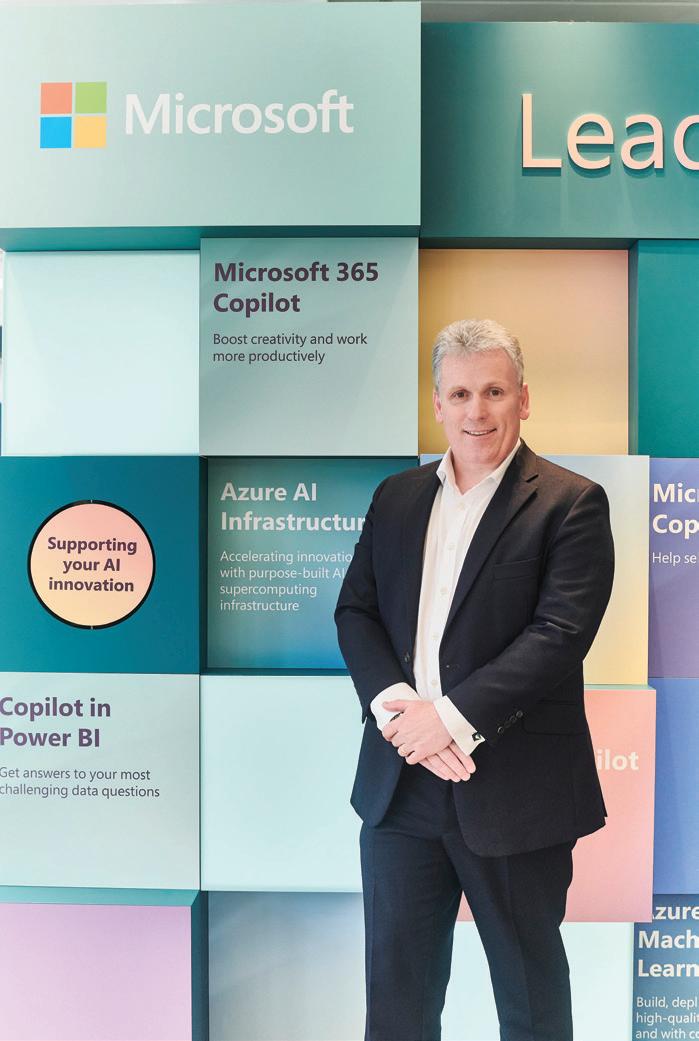
Sustainability is a pressing global issue, and technology has the potential to play a significant role in addressing it. Can you share some insights into Microsoft’s sustainability initiatives and how you are leveraging technologies like AI and cloud computing to drive positive environmental impact?
Microsoft utilises AI and cloud computing to enhance sustainability efforts, from improving data transparency and insights to developing novel solutions for a sustainable future and positive environmental impact. Four years ago,
Microsoft committed that, by 2030, we would become carbon negative, zero waste, water positive, and protect more land than we use. Since then, we have seen significant changes both in technology and in improving our understanding of what it will take to meet our climate goals. Modern technologies, including Generative AI, are new innovations that can help to understand and address the global climate issue.
We are focused on improving sustainability measurements by harnessing the power of digital technology to garner better insight
and action. As well as increasing efficiency by applying datacenter innovations that improve efficiency as quickly as possible. Along with forging partnerships to accelerate technology breakthroughs through our investments and AI capabilities, including greener steel, concrete, and fuels. Along with advocating for public policy changes that will accelerate climate advances.
In addition, our Microsoft Research, and AI for Good teams are also working to accelerate solutions and develop climate resilience with AI. For example, we are collaborating with the United Nations to research the use of AI to advance the Early Warning for All Initiative, with a goal of better understanding the populations that may be at risk of extreme weather events and other threats.
Reskilling and upskilling the workforce is crucial in the digital age. What initiatives has Microsoft undertaken to support governments in developing the necessary AI digital skills within their workforce to facilitate successful digital transformations?
The ubiquity of AI’s opportunities to make a real difference across organizations and for the public means that governments need to approach AI skill building in a unique way. Governments are not only facing the challenge of keeping up with the rapid pace of technology, but they are also grappling with a shortage of skilled workers. 71% of companies are already using some form of AI and another 21% plan in the next year and yet 52% of business report the lack of skills is the biggest block to scaling AI. The Public Sector also feel they lack the strategic knowledge, technical skills, and solution efficiency to effectively implement AI. Microsoft recognizes this and has engaged several million people globally, and continues to grow on this number, to help them learn how to use our technology and have the right skills to accelerate AI implementation and innovation. To ensure governments have the knowledge and skills develop
coherent AI strategies they need to shift to a culture of AI transformation requires investment at all levels to shift to a culture of learning with a skills-first approach to AI, which emphasizes skills and competency across the entire workforce.
To accelerate a skills-first approach for AI governments need to take a structured approach to AI skill building based on individual and team goals and ensure upskilling happens across every function areas –from leadership to IT, from Developer to business users. To help Microsoft as a trusted partner of governments we offer comprehensive curated resources, tools, and guidance to build the AI and digital skills needed to execute new AI innovation projects and achieve the business objectives required. We deliver a raft of training from the Cloud, across our products and for AI. For AI, we provide a 4 stage AI skill Learning Journey that starts with Understanding AI – a foundation of concepts, definitions and key terms followed by Preparing for AI and providing essential knowledge on getting infrastructure ready to adopt AI and our copilot suite. After which there is a module on Using AI and discovering the skills to use our Gen AI Copilots and how to maximize benefit before the final module on building AI Solutions and learning how to build and integrate AI experiences into your own apps and services. All designed to give Governments and Businesses the opportunity to develop the requisite skills to operate
our products, our hosted partner products or build their own solutions with custom models, Studio Copilot from the Cloud.
Microsoft’s partnership with OpenAI has garnered significant attention. Can you elaborate on how this collaboration is shaping the future of AI development, and what implications it might have for government agencies seeking to leverage AI capabilities?
We have had a wonderful partnership with OpenAI. In the past 18 months, Gen AI has grown significantly, and the teams have been working diligently to advance our AI platform and build new supercomputing infrastructure and collaborate with our partners at OpenAI to move that frontier forward. I think that the models we use will only get smarter, in general terms. Just consider how much smarter GPT-3 to 3.5 to 4 became, and how you could use it for many things –the general capability and overall intelligence keeps improving. But as the models got smarter, safety was also essential and it got safer with safety tools, the security of Azure and following responsible AI practices.
Also, as the capability has increased, we have seen changes in speed and cost, with the newly announced GPT-4o, a multimodal model (text, speech, images, video, as input and output). For instance, you can see this in what happened with GPT-4. It’s 12x cheaper and 6x faster since its launch, and that is the kind of


progress you will keep seeing as we evolve the system architecture.
Looking forward, our partnership with OpenAI will surely keep growing and the benefits can be huge for governments and businesses who use the tools in their daily processes.
Microsoft and partners like OpenAI are putting a lot of effort and capital on an unmatched scale, to make sure that we are constantly developing
a platform that adds value and is trusted by our customers.
The hyperscale cloud is underpinning the massive growth in AI and other emerging technologies. How is Microsoft’s Azure platform evolving to meet the increasing demands for scalable and secure cloud infrastructure, particularly in the public sector?
Last November, we announced the most powerful AI simple computer in the Cloud for training AI and over the past six months, Microsoft has added 30 times that supercomputing power to Azure At the same time. Our latest datacenter designs are purposebuilt for AI workloads so that we can effectively and responsibly use every megawatt of power to drive down the cost of AI. We are also incorporating

advanced data center cooling techniques to fit the thermal profile of the workloads and match them to the environment and the location where it operates. Our custom IO hardware and server designs allow us to provide dramatically faster networking, remote storage, and local storage throughput. All of this is driving an end-to-end approach that is really helping us get to the
unprecedented scale and expansive coverage required. In addition, for certain scenarios we are providing our Microsoft Cloud for Sovereignty and Confidential Compute capabilities to meet certain local compliance standards.
Cybersecurity threats are a constant concern for governments handling sensitive data and critical infrastructure. What strategies and solutions are Microsoft offering to enhance cyber resilience and protect against evolving threats?
We are adapting to the new threat landscape comprised of sophisticated, well-funded nationstate threat actors, and making significant changes to mitigate those threats through our Secure Future Initiative (SFI) that is focused on Secure-by-Design, Secure-by Default, and Secure Operations. SFI shows we are at an inflection point where the best practices the industry had adopted over the last couple of decades are no longer always viable given the changing nature of cyber threats and the strategies and tactics that sophisticated, well-funded threat actors are using. In this new era of AI, where AI is foundational to how we develop and defend software, we needed a whole new paradigm for security and that’s what SFI represents to deliver the security requirements.
For governments and customers, we offer the insights and the defensive capabilities of the Microsoft Cloud to defend against emerging threats. Zero Trust Architecture and Multifactor Authentication, along with training and assurance, are some of the key features for having a secure and resilient architecture. We also support our customers through our Cyber Defence teams. We have over 65 trillion signals analysed per day. That is over 750 billion signals per second, analysed using advanced data analytics and AI algorithms to identify and protect against digital threats and criminal cyberactivity. With more than 10,000+ Microsoft security and
threat intelligence experts, including engineers, researchers, data scientists, cybersecurity experts, threat hunters, geopolitical analysts, investigators, and frontline responders worldwide, we partner with our customers and this partnership acts as a vital force multiplier for collective resilience and protection against these everevolving threats.
As a technology and business leader, what advice would you give to government leaders and decision-makers embarking on digital transformation initiatives, particularly in terms of navigating the complexities of emerging technologies like AI and ensuring successful adoption?
Don’t hesitate or procrastinate on your digital transformation initiatives or you will fall behind. Identify your quick wins and scaling plans and go ahead. Leaders should focus on some key areas, and they should also personally lead the culture and skill change journey as well as the technology drive needed. Governments need to change how they think about data and AI and govern the transformation at the highest levels to succeed. They need to be agile in their policies, regulations, procurement rules and finance position to allow for multiyear as a service. They also need to have strong executive sponsorship and governance for the public and internal experience to build trust in the technologies early if they want to flourish in a fast-changing world.
Finally, for those Governments that don’t have a Cloud First policy they limit their AI innovation and therefore need to modernize by considering a comprehensive on-premise data centre rationalization programme and how to operate a hybrid cloud infrastructure to get the agility, innovation, and creativity that the hyperscale cloud can securely offer while increasing productivity and value. By not taking action, governments may miss out on the productivity gains that AI can deliver.
AI is the hottest topic in the universe. Pair AI with cyber security and the possibilities (and challenges) are staggering. For many security professionals, it’s a foregone conclusion that incorporating intelligence into cyber security will improve cyber defences battered by sophisticated cyberattacks. Unfortunately, cybercriminals, too, have jumped aboard the AI bandwagon, weaponising their digitised assaults.
Check Point partnered with market researchers at Vanson Bourne to understand how security professionals are adopting Generative AI (GenAI) is their practices. A handful of key findings from their research are discussed here.
Despite over 70 percent of respondents feeling confident about their organisation’s defences, eighty-nine percent countered their optimism by acknowledging that employing qualified people was challenging. The cyber security skills gap puts a serious damper on how effective organisations can assemble the right defences against AI-infused cybercrime.
“An overwhelming 89% of IT and security professionals report a significant skills gap, underscoring the urgent need for innovative solutions.”
Surveyed professionals said the skills gap significantly hampers an organisation’s ability to conduct efficient security operations. A substantial 98
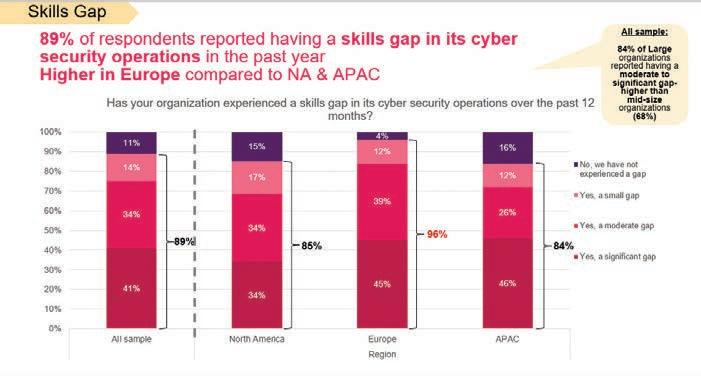
percent of those affected reported an “impact” on their security operations, with 40 percent citing a “strong impact.”
No organisation, large or small, can ignore the potential impact of a major cyberattack. As a result, surveyed organisations said they have turned to AI-powered tools to boost cyber security, including incident response, malware protection, and data loss
protection. Clearly, AI is etching its role in providing better protection of the digital landscape.
“97-99% of organisations utilise AI-powered tools, with a significant shift towards GenAI for a comprehensive security strategy.”
Organisations have also embraced GenAI for strategic purposes. A significant portion of respondents said they have been leveraging GenAI for

over a year to enhance cyber security against sophisticated threats. Improving incident response rates was cited as an example.
All global regions said GenAI tools offer a better understanding of user behaviour and anomalies. However, respondents in Europe were less in agreement on whether AI can be linked to higher efficiency such as enhanced threat prevention and detection, streamlined security operations and resource allocation, and reduced manual work for their teams. Nearly 50 percent of APAC professional indicated GenAI offering streamlined security operations and resource allocation, the highest of the three global regions.
The skills gap paradox and GenAI
Bridging the Gap: GenAI can be an ally in addressing the skills gap. It offers a way to augment existing capabilities and improve efficiency, especially in sectors with a high demand for cyber security proficiency.
“Gen-AI is instrumental in closing the cyber security skills gap, with 98% of affected organisations recognising its impact on operational efficiency.”
The impact of GenAI varies across sectors, with particular benefits observed in healthcare and finance. These sectors recognise Gen-AI’s potential to significantly reduce manual work and increase the efficiency of incident response.
To this survey question, “Thinking about GenAI / AI/ML Deep-Learning, to what extent do you agree or disagree with the following statements,” most respondents agreed that AI tools will improve their efficiency, increase their incident response rates, and help close skills gaps in their organisations. Here are other results:
• GenAI has/can significantly reduce manual work for our security team: Healthcare (32% lower)
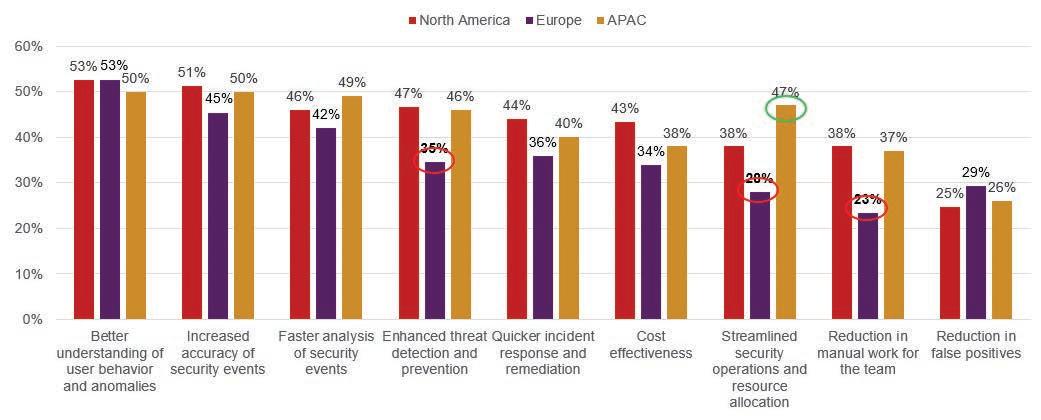
• AI/ML Deep Learning has/can greatly increase our efficiency with incident response: Energy, oil/gas, and utilities (36% higher)
• Gen AI has/can significantly increase our catch rate: Finance/ banking/investments (35% higher)
AL/ML Deep Learning has/can help to substantially bridge the cyber security skills gap in my organisation (for those experiencing skills gap in cyber security operations): Finance/banking/investments (28% improvement)
The commitment to integrating GenAI into cyber security is strong, with 90 percent of organisations planning to prioritise AI/ML and GenAI tools. This is accompanied by an anticipated increase in budget allocations for GenAI tools.
“90% of organisations prioritise investments in GenAI tools, reflecting a strategic shift towards innovative cyber security solutions.”
While the outlook is optimistic, concerns and challenges do remain. Organisations highlight the importance of keeping AI models updated while being cognisant of the challenges, such as ensuring compliance with data regulations.
The journey towards a GenAI-integrated security landscape will offer security leaders both rewards and challenges. However, it’s clear, GenAI will help transform organisations as cyber security providers incorporate greater intelligence. Embracing GenAI with strategic foresight will pave the way for a more secure and resilient digital future.

AI’s foothold on our lives is looked upon as a supporting tool for intelligence. Not a replacement for human ingenuity, despite decades-long dissent and technological malaise. AI experts agree, the trends on the horizon are pressing. In the short term, the integration of AI into the workforce will create more jobs, though its transition would make some professions in a ubiquitous AI job market, obsolete and outmoded.
One of the most commonly used types of AI for business is machine learning: the processing of extensive amounts of data, streamlined through
the Internet of Things and connected devices. Machine learning is most effective at identifying trends, patterns and anomalies in data.
Another facet of AI is its deep learning for business application. By using groups of interconnected AI ‘nodes’, linear reasoning can be achieved and utilised. The main difference between machine learning and deep learning, is the former can plateau once certain amounts of data has been captured. The latter, can exponentially improve in performance as more and more data is processed.

The World Economic Forum found that 75% of companies would implement AI in the next five years. Almost 40% of global employment is exposed to AI, including high-skilled jobs. In advanced economies, AI could lean into 60% of jobs, lowering labor demand. In emerging markets, AI exposure is forecasted at 40%, and AI disruption to low-income countries is predicted at 26% in the foreseeable. Many countries falling into the emerging markets and low-income bracket are lacking in the infrastructure or skilled workforces to facilitate an AI overhaul to the extreme.
AI’s potential business scope extends to productivity, the streamlining of processes and decision making. For many businesses, future proofing operations, at minimum, would need to see the use of AI driven chatbots, for conversational engagement and personalised responses. Or, predictive maintenance, using sensor data and machine learning algorithms to predict equipment failures; plus personalised marketing campaigns, harvesting customer data from habitual online touchpoints.
Enhanced customer experience, in future-proof terms, would see AI-enabled tools for sentiment analysis, with the creation of personalised recommendations, fostering loyalty and customer retention. Augmented reality would feature in the melting pot of AI adaptability for business, plus the use of autonomous decision making, AI-powered cybersecurity, safeguarding businesses against cyber threats, allowing companies to stay abreast of evolving cybercriminal practice.

AI in healthcare has seen innovations in radiology, with the automation of image analysis and diagnosis, assisting in highlighting areas of interest and therefore reducing human error. Other areas AI could aid is drug discovery, patient risk identification and primary care.
AI’s digital right hand is cloud computing, and its no reminder to highlight its importance in streamlining business. A cloud of clouds strategy delivers computing services across the Internet, or cloud. The advantage of using the cloud, is that an organisation only pays for what is used, helping to lower business costs.
Cloud services help organisations handle and act on information rapidly. Globally, many companies are racing toward cloud infrastructure, with forecasts for cloud spending expecting to hit $679 billion. And perhaps more staggering: by 2026, public cloud spending will overshadow 45% of all enterprise IT spending, an increase from under 17% in 2021.
PrivatBank, one of Ukraine’s largest banks, migrated all its operations to the cloud, opting for Amazon’s Web Services (AWS) to shift 270 applications, four petabytes of client data,
from 3500 Ukraine-based servers. Back in Britain, Sony adapted remote work setup by using AWS cloud services, helping with the transition of this kind of work, without disruption to productivity, despite the global throes of COVID-19.
Virtually, the cloud’s scalability is unlimited. Infrastructure and hardware costs become redundant, and administrative staffing needs would dwindle. Many companies report significant savings from using the cloud, streamlining Agile workflows, slashing deployment times and simplifying resource management, switching IT costs from fixed to variable.
A responsible, sustainable future for cloud use, might look something similar to Microsoft’s recent advancements in their data centres. Methods like the airside economisation approach improves cooling efficiency, and coupled with Microsoft’s attempts to increase the use of renewable energy sources, could be a way forward for a greener digital future.
In line with the Paris Agreement’s carbon neutrality goals, Amazon have voiced their aim of achieving targets 10 years early, aiming for net-zero carbon by 2040. Google too, have looked
at greener practices, using machine learning technology in data centres to boost efficiency, and improve cooling efficiency.
Trends outlined for the future of cloud services, including innovations such as higher adoption of hybrid and multi-cloud environments. By using multiple cloud providers, organisations can achieve higher operational efficiency. Integration of AI and machine learning in cloud services will gain more traction in the future, along with edge computing, speeding up data processing in a local system. Use of edge computing in the future will render firmer security for organisations and save capital.
The demand for cloud computing, according to Gartner, by 2027, is expected to become a key driver for business and the common style of computing. Regardless of size, cloud computing can benefit every business, in storing data, development, and perform other business operations. Statistics from Grand View Research estimate the worldwide public cloud services market is forecast to grow 14.1% from now to 2030.
The quest to build machines that can reason, learn and act intelligently is forthcoming. Just last week, AI models outperformed humans in tests to identify mental states, plus, OpenAI and Google are set to launch supercharged AI assistants, promising to be leaps ahead of tools like Siri or Alexa.
AI-powered technologies in machine learning algorithms and robotic automation are optimising production, minimising downtime and speeding overall efficiency in the manufacturing world. Smart factories equipped with AI-driven systems can analyse vast datasets in real time, creating valuable insights that prevent equipment failures and reduce unplanned downtime.
The AI and cloud services crossroad is an important annal for society and will shift many areas of business. What’s important is to maintain the balance of technological advancement and humane responsibility.

Could you elaborate on Microsoft’s mission in the cybersecurity landscape and how it aligns with the evolving threats in today’s digital world?
When it comes to working with Public Sector, Microsoft’s mission in the cybersecurity landscape is to empower every person and every government on the planet to achieve more securely. With the growing reliance of nations on their digital ecosystems to provide resident and citizen services, the cyber domain has become as crucial to national security as the traditional domains - land, air, sea, and space.
Unfortunately, today we see an astonishing 150% increase in cyberattacks on governments. In fact, 53% of all cyberattacks are focused on government agencies and critical infrastructure. Moreover, cyber offensive
adversaries have started to monetize and weaponize AI-enabled tools with an 85% rise in cyber-attacks attributed to nefarious actors using AI-based technologies. All this in a world where we anticipate 3.5 million cybersecurity jobs to go unfilled through 2025. Governments need guidance and support on this uneven playing field and Microsoft is well positioned to partner with them in this ongoing battle.
As the Global Cybersecurity Lead for Public Sector, what are the primary responsibilities of your role, and how do you navigate the complexities of cybersecurity on a global scale?
My job is to partner with Public Sector organizations globally to assist them in crafting modern cybersecurity strategies that address their short and long-term challenges and
provide them with actionable insights to defend their digital ecosystem. We leverage our unique global cybersecurity vantage point, our interaction with our global security partners and by listening to the real world and unique needs from our public sector customers to shape our perspective. Using this unique global perspective, we then identify trends, gaps and patterns that inform the prioritized focus areas that in turn gets translated into functional use cases that our Microsoft security engineering team in collaboration with our security partners can then incorporate into our platforms to keep their digital environments safe.
In your opinion, what are the key cybersecurity trends shaping the industry, and how is Microsoft adapting to address these trends?


We are seeing several recent trends that change the way we must approach cybersecurity:
Geo-political tensions are adding to the volume and sophistication of cyber attacks aimed at public sector organizations and critical infrastructure entities.
The proliferation of AI-cyber tools for malicious use is dramatically tilting the advantage to attackers.
Cyber talent shortage makes it difficult for governments to attract and retain skilled cybersecurity professionals due to high demand and low supply coupled with competition from private sector.
Increased pace of technological advancement cybersecurity
strategies and defenses can quickly become obsolete and cyber defenses must be continuously updated.
To address the challenges that result from these trends, Microsoft is partnering with Public Sector entities to guide them through a cyber security modernization journey that helps them update their security operations processes and modernize their cybersecurity defense capabilities to respond to these new threats from hostile nationstate actors. In addition, Microsoft has developed the first Gen-AI Cyber Defense tool that will shift the advantage to public sector defenders.
Could you shed light on Microsoft’s approach to cybersecurity partnerships and collaborations with other organizations, both within and outside the tech industry?
We are firm believers that Cybersecurity is a team sport and requires engaging in proactive and collaborative efforts with a cross-industry ecosystem that includes governments, industry partners, civic leaders, and academic institutions, to share threat intelligence, promote best practices, and advocate for cybersecurity policies and standards, and of course provide cybersecurity thought leadership and training. We believe that by working together, we can make the digital world a safer place for everyone.

With the increasing frequency and sophistication of cyberattacks, what strategies does Microsoft employ to enhance resilience and response capabilities?
Last November, we launched the Secure Future Initiative (SFI) to prepare for the increasing scale and high stakes of cyberattacks. SFI brings together every part of Microsoft to advance cybersecurity protection across our company and products.
Since then, the threat landscape has continued to rapidly evolve, and we have learned a lot. The recent findings by the Department of Homeland Security’s Cyber Safety Review Board (CSRB) regarding the Storm-0558 cyberattack from last July, and the Midnight Blizzard attack we reported

in January, underscore the severity of the threats facing our company and our customers.
Microsoft plays a central role in the world’s digital ecosystem, and this comes with a critical responsibility to earn and maintain trust. We must and will do more.
We are making security our top priority at Microsoft, above all else—over all other features. We’re expanding the scope of SFI, integrating the recent recommendations from the CSRB as well as our learnings from Midnight Blizzard to ensure that our cybersecurity approach remains robust and adaptive to the evolving threat landscape.
We will mobilize the expanded SFI pillars and goals across Microsoft and this will be a dimension in our hiring decisions. In addition, we will instill accountability by basing part of the compensation of the company’s Senior Leadership Team on our progress in meeting our security plans and milestones.
Below are details to demonstrate the seriousness of our work and commitment.
How does Microsoft perceive its role at the core of the cybersecurity crisis, and what initiatives or innovations is the company undertaking to mitigate cybersecurity risks for its customers and partners globally?
We at Microsoft see ourselves as an active and key participant in an ecosystem of cyber defenders whose priority is to protect the digital ecosystem from those who seek to misuse it. To fully answer this question, I think it’s appropriate to use two quotes from our Security leaders.
We believe Microsoft – independently and through close partnerships with others in private industry, government and civil society – has a responsibility to protect the digital systems that underpin the social fabric of our society and promote safe, secure computing environments for every person, wherever they are located “ Tom Burt. Corporate Vice President, Customer Security & Trust
Microsoft runs on trust and this trust must be earned and maintained. As a global provider of software, infrastructure, and cloud services, we feel a deep responsibility to do our part to keep the world safe and secure. Our promise is to continually improve and adapt to the evolving needs of cybersecurity. This is job number one for us. Charlie Bell, Executive Vice President, Microsoft Security
Last November, we launched the Secure Future Initiative (SFI) to prepare for the increasing scale and high stakes of cyberattacks. SFI brings together every part of Microsoft to advance cybersecurity protection across our company and products.
Route optimisation has become ever more important in recent years. The rise in ecommerce has created new routing pressures, especially in the last mile; while rising fuel costs, the push towards net zero, load theft have placed the spotlight on using preferred refuelling locations and the need for safe, comfortable parking, especially overnight.
Layering these demands over the traditional goals of controlling costs and meeting tight deadlines has highlighted the limitations of generic mapping and routing solutions. From large HGVs stuck in tiny rural lanes to the damage – and cost – incurred when a HGV hits a low bridge or the risk of compliance breach associated with taking a hazardous load through a tunnel without permission, many transportation companies have learnt the painful lesson of relying on a phone’s satnav.
Consumer mapping technologies may be ubiquitous but they lack the depth of insight required to manage the complexity associated with the commercial movement of goods. As Kate Legnola, Sr. Product Manager, Map
Data at Trimble explains, dedicated commercial route mapping technology has been developed to address the very specific demands of transportation fleets, from height and weight restrictions and hazardous materials transport designations to improving driver well-being and safety.

Reliance on online maps has become standard for most drivers but effective commercial route optimisation requires far more depth and breadth of insight than the basic, ubiquitous directions that cannot differentiate between a driver in a heavy goods vehicle or a two-seater sports car. Commercial mapping intelligence has evolved beyond simple visualisation on a map to offer a wide range of insights on business and driver behaviour that can significantly enhance fleet management. Complex routing algorithms are used to determine the most efficient routes for delivery or service vehicles by considering factors such as traffic patterns, road permissions, congestion and clean air zones, low bridges, narrow lanes and fuel consumption. Data, including not only construction of new infrastructure, but also
any changes in existing restrictions is continually updated following routine bridge and tunnel inspections undertaken by highways authorities to give planners confidence in the safety and legality of the designated route.
Transportation companies can leverage this depth of information to plan based on different priorities, comparing routes based on sustainability, cost and time objectives. The ability to offer clients different routing models provides a competitive advantage by enabling a transport business to demonstrate how it is supporting a client’s sustainability reputation, for example. It is also assisting fleets in future-proofing their operations so they can better serve and meet their sustainability goals. Among them are a better ability to adhere to
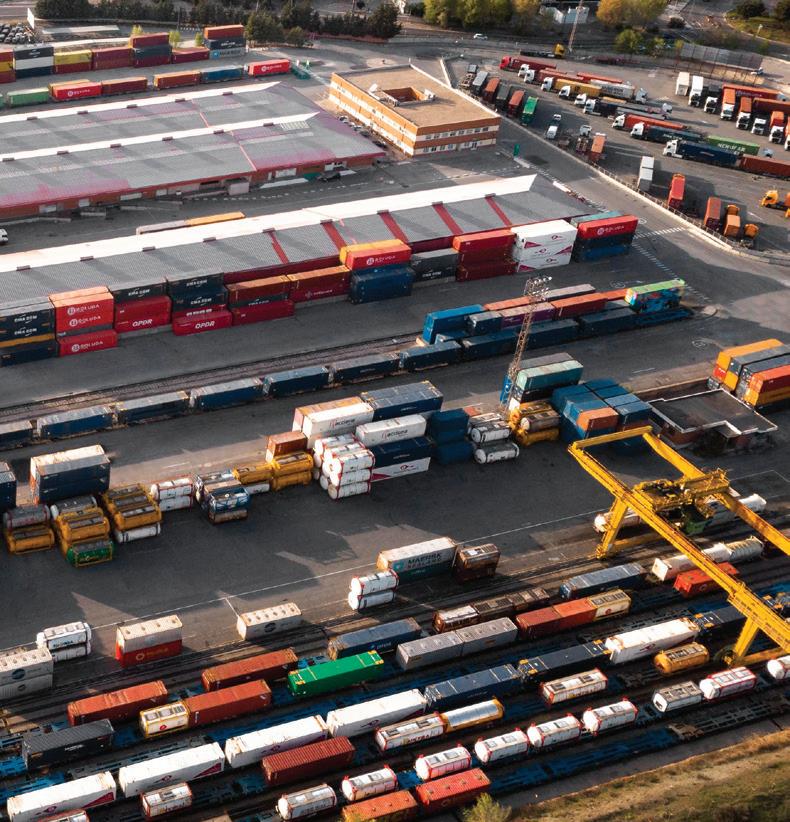
environmental rules and guidelines, a better understanding of vehicle carbon footprint, a reduction in operating costs with the efficient allocation of vehicles based on electric vehicles thus achieving long-term, sustainable cost reduction.
Complex algorithms are used to determine the most efficient routes for delivery or service vehicles by considering factors such as traffic patterns, road permissions, congestion and clean air zones and low bridges.. Route intelligence software can also track dwell time, a perennial problem for all transportation companies. Using precise polygonal geofencing to improve the accuracy of arrival and departure notifications, the overall journey time, including both travel and stop time, is more precise. It is also enabling companies to better
understand the overall efficiency and performance of the fleet, information that can help to reduce empty miles, cutting costs and reducing emissions whilst adding revenue.
Indeed, by investing in smart mapping technology, elements such as planning processes will automatically consider drivers’ hours of service (HOS) and can include specific locations for resting and parking to avoid the risk of drivers being compelled to park up on the roadside which is both uncomfortable and unsafe. Further, using intelligent route mapping, transportation companies can optimise loyalty programs and discounts around specific brands of fuel to optimise routes, understand freight spend, and plan routes more efficiently. The routes can be designed around the use of rest stops
preferred by drivers wherever possible to ensure they have access to good quality food and showers.
Driver safety can be further enhanced with vehicle specific information throughout the journey especially regarding the trickier problems that can arise during the last mile. Commercial mapping intelligence solutions pinpoint the actual final locations, such as the delivery entrance to the shopping centre rather than the consumer entrance used by the generic mapping solutions. In addition, transportation companies can opt to customise the mapping, overlaying a preferred approach path for specific locations to ensure every driver, however new to the business, has the optimal, safe route to each location, whether that is a store, warehouse or distribution centre.
For transportation companies wrestling daily with the need to mitigate disruption, reduce costs and meet escalating customer demands, intelligent route mapping and routing is becoming a strategic imperative. Companies can no longer afford to rely on traditional manual route planning processes or allow drivers to rely on their own generic mapping systems. The risks of delays, damage and missed opportunities are simply too high.
Intelligent route mapping provides businesses with a chance to improve day to day planning and ensure routes are optimised for each vehicle, taking into account the essential features of weight, size and hazardous materials. It gives the chance to focus on both driver performance and well-being, enabling companies to prioritise access to safe overnight parking and rest stops. Finally, it also delivers vital insight into the intricate interplay of suppliers, processes, and partners that allows transportation companies to optimise operations, intelligently consider innovations in areas such as EVs, and confidently navigate today’s complex marketplace.

In a world where environmental consciousness is increasingly important for businesses and consumers alike, industries are working to become more sustainable. Nowhere is this more evident than in metal production, where innovative practices and collaborative efforts
are reshaping today’s landscape; we’re seeing a green metals revolution take place, driven by low-carbon aluminium and steel production and advances in recycling.
From eco-conscious consumers opting for products with lower carbon footprints, epitomised by the success
of and increasing number of second-hand selling apps, to businesses aligning with Environmental, Social, and Governance (ESG) goals, the shift towards sustainability is undeniable. The journey towards sustainability in metal production is multifaceted, driven by a collective commitment to impact the planet less, prompting producers to explore greener practices and material options.
At the intersection of sustainability and innovation lies design. Designers hold significant influence in shaping the environmental impact of products, with approximately 80% of a product’s environmental footprint determined during the design phase. This underscores the importance of integrating sustainability into the design process of the green metals revolution from the outset.
Specifically, designers play a pivotal role in driving sustainability via:
• Selection of eco-friendly materials: They can choose materials with lower energy requirements and source from suppliers with responsible practices like sustainable forestry or recycled content.
• Extending a product’s life cycle: Through strategies like making repairs and product upgrades ingrained into initial designs, or designing for multi-functionality, designers can encourage consumers to keep and use products for longer.
• End-of-life considerations:
Designers can prioritise recyclability or biodegradability to minimise landfill waste. They can also explore innovative concepts like product-as-a-service models, where ownership remains with the manufacturer and encourages responsible material recovery.
By collaborating with material producers and embracing these sustainable design principles, designers can create products that not only meet consumer demands but also contribute to a more circular economy, where resources are kept in use for longer and waste is reduced.
Understanding this collaborative approach in the metals industry can lead to a future where design is a powerful force for positive environmental change.
The path towards sustainable metals production isn’t a solitary trek, but a shared journey. Imagine producers and designers working hand-in-hand, championing eco-friendly solutions at every step. A good example of this collaborative spirit comes from Hydro’s innovative CIRCAL 100R, the first ever aluminium alloy made entirely from post-consumer waste. This project, recently showcased at Milan Design Week 2024, underlines the power of partnerships with designers to drive sustainability in the metals industry.
Since designers have significant influence on material selection, open communication is key. Hydro’s push for clear labelling empowers designers to make informed choices. Knowing a material’s environmental impact allows designers to avoid “greenwashing” and make truly sustainable design decisions, benefiting both the environment and consumers.
Projects like CIRCAL 100R showcase the true potential of collaboration and knowledge sharing within the industry. By transforming everyday scraps into attractive, functional design objects

with mass production potential, they inspire manufacturers to embrace sustainable practices.
Ultimately, consumer choices drive demand for sustainable products. Collaboration extends to educating consumers about the environmental impact of materials. When consumers understand the choices they make, they are empowered to shop with a focus on sustainability. Consumers are increasingly demanding visibility into the origins and environmental impact of the products they purchase, driving companies to prioritise transparency throughout the supply chain. By providing clear labelling and traceability information, companies can build trust and accountability with consumers. This transparency not only fosters consumer confidence but also incentivises companies to adopt greener practices and materials.
Hydro is committed to this approach, aiming to recycle post-consumer scrap ranging from 850,000 to 1.2 million tonnes by 2030, helping to drive a NOK 2 billion greener earnings uplift – a significant leap forward.
The CIRCAL 100R project generally serves as a roadmap for unlocking progress in sustainable metals production. This helps to pave the way for a circular economy for metals, where resources are maximised and
waste minimised. The CIRCAL 100R is just one example, but it exemplifies the promise of working together to tackle the wider issue of sustainable production across many industries.
While significant progress has been made in the green metals revolution, challenges remain on the path towards sustainability. From technological barriers to regulatory hurdles, stakeholders must navigate a complex landscape to achieve meaningful change.
However, amidst these challenges lie opportunities for innovation and collaboration. By leveraging technology, embracing circular economy principles, and fostering partnerships across industries, stakeholders can overcome barriers and accelerate the transition towards sustainable metals production.
The green metals revolution is not just a trend—it’s a fundamental shift towards a more sustainable future. By harnessing the power of collaboration, innovation, and sustainability, stakeholders across the metals industry can pave the way for a greener, more prosperous world.

The latest Chinese activity data was something of a ‘mixed bag’, with continued weakness in consumption emphasising the need for greater fiscal and monetary support to ensure a sustainable economic recovery.
Retail sales, in April, rose 2.3% YoY, a noticeable drop from the 3.1% pace notched a month prior, and considerably below consensus expectations for a 3.7% YoY increase. The monthly data also provided little cause for optimism, with sales – as near as makes no difference – stagnating on an MoM basis.
In contrast, the industrial production figures do paint something of a brighter picture. On a YoY basis, production rose 7.7% in April, a significant quickening from the 4.5% pace seen in March, and a substantial upside surprise compared to the 5.5% consensus.
Furthermore, on an MoM basis, production rose just under 1% last month, the fastest pace in more than three years, providing further evidence of the relative resilience of the domestic manufacturing sector.
Taken together, the retail sales and industrial production figures provide further evidence, and reinforcement, of the ‘K-shaped’ economic recovery that China is currently undergoing, particularly when one also takes into account the 1.5% YoY export growth seen last month, underscoring that international demand for Chinese goods remains relatively solid.
Naturally, this demand continues to underpin growth in the manufacturing sector, which has largely fuelled the Chinese economy at large this year.
In contrast, a litany of domestic issues, including the prolonged and protracted
property crisis, continues to weigh on consumer sentiment, and spending, with data out earlier this week having shown credit falling for the first time in almost two decades. While reports indicate that measures to prop up the property sector are under consideration, including plans for local governments to purchase unsold homes from embattled developers, this feels rather like an attempt to paper over the cracks.
In addition, Chinese authorities have been attempting to turn the sector around for at least three years, to no avail, since the debt crisis began in mid-2021. On top of this, the significant detrimental impacts of such a forced buying policy on local government balance sheets must be taken into account, particularly with overall local government debt sitting north of $9tln, posing a substantial risk to broader financial stability.

Nevertheless, the strong desire to support the property sector underscores how pivotal a more stable real estate environment is in shoring up both consumer confidence, and consumption – a shoring up that, clearly, given today’s figures, is much-needed, in order to unlock the next leg of economic recovery, with manufacturing only able to support a sustainable recovery to a relatively limited degree.
Such a sustainable recovery is likely to be required in order to provide a more solid bull case for Chinese equities, even if the benchmark A50 index has recovered over 20% from the mid-January lows.
This is particularly true given the long-standing, and justified, concern among international investors over the uninvestable nature of China, especially when other

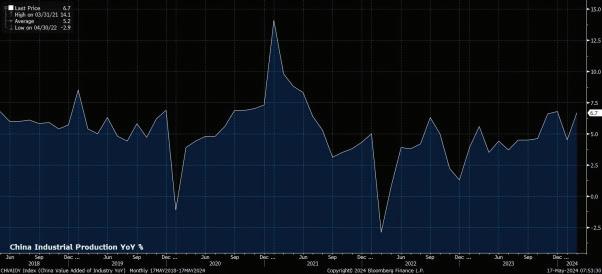


regional options for Asia equity exposure - such as India and Japanappear increasingly favourable. The Japanese market is one where the bull case is particularly solid, with ongoing corporate reforms aimed at improving company profitability, and increasing cash returns to shareholders, coupled with continued weakness in the JPY, likely to fuel inflows, and equity upside, for some considerable time.
In today’s rapidly evolving business landscape, the ability to manage and utilise data effectively is paramount to sustainable growth. Traditional master data management (MDM) solutions have been the go-to for many companies to handle their complex datasets. However, these legacy systems often falter under the burgeoning scale and diversity of modern data, leading to inefficiencies and lost opportunities. This is where AI-powered Golden Records come into play, offering a new paradigm that is transforming the way businesses harness the power of their data.
 By Anthony Deighton (pictured), CEO at Tamr
By Anthony Deighton (pictured), CEO at Tamr

A golden record represents the pinnacle of data management: a single, authoritative, accurate version of a business entity’s data across multiple data sources and datasets. This hardto-achieve level of data integrity and comprehensiveness is now possible through an AI-first approach. By leveraging artificial intelligence (AI) to create golden records, companies can achieve faster time to value, enabling them to sell more effectively, enhance marketing outcomes, uncover new opportunities, reduce operational costs, and make more informed decisions. Essentially, golden records streamline data management, leading
to more accurate insights, improved decision-making, and stronger business performance.
Golden records are the cornerstone for organisations striving to gain a competitive edge and secure their leadership position in an increasingly complex, dynamic marketplace.
One of the most significant advantages of AI-powered Golden Records is their ability to quickly and effectively cleanse and curate data at scale. Unlike traditional MDM, which relies heavily on manual rules and processes that are both

time-consuming and prone to error, AI-driven systems use machine learning to automate data management tasks. This not only speeds up the process but also ensures a higher level of accuracy and reliability in the data sets. Additionally, the integration of AI allows for realtime data updating, which keeps the information relevant and highly usable without manual intervention, ensuring that businesses can react swiftly to new information or market changes.
For example, a major UK bank faced significant challenges with its enterprise data silos, which impeded its ability to make fast lending decisions. By implementing AI-powered
Golden Records, the bank was able to unify numerous sources and millions of customer records in just a few weeks, dramatically improving the speed and accuracy of its operations.
The role of human refinement in AI-powered data management cannot be overstated. While AI provides the technological backbone, the nuanced understanding and judgement of human experts are critical for achieving the highest data integrity and utility. Human experts play a pivotal role in supervising AI outputs, refining data by correcting inaccuracies, and providing insights that only come from human experience and understanding of context. This synergy between AI capabilities and human expertise ensures that the data not only remains accurate but also contextually appropriate, enhancing the overall reliability of the data management process.
The dynamic nature of data requires solutions that can adapt and evolve at a similar pace. AI-powered Golden Records meet this need by enabling the creation of data products — consumption-ready data sets that are aligned with business entities and can be easily reused and scaled as data changes. This capability is critical for businesses that need to stay agile and responsive to market dynamics. AI-powered systems are equipped to handle the vast influx of data from IoT devices and other digital touchpoints, making them indispensable for businesses that operate across multiple digital platforms.
The adaptability of these systems is not just about handling more data but also about integrating a variety of data types from disparate sources, ensuring that all information is synchronised and up-to-date. This level
of flexibility is a game-changer for companies looking to leverage their data for strategic advantages.
The agility of an organisation is significantly enhanced by the deployment of AI-powered Golden Records. These systems fill data gaps and democratise data access across teams, which is essential for maintaining smooth operations during scaling. By breaking down data silos and centralising data control, businesses can empower their teams to make informed decisions quickly and efficiently. This approach helps in fostering a culture of datadriven decision-making, where data is not just a strategic asset but a core aspect of everyday business operations, driving innovations and efficiency at all levels.
For instance, a leading multinational financial services company was able to decommission multiple MDM solutions and embrace a single AI-powered system, improving data accuracy significantly within a short period. This not only streamlined their IT landscape but also provided a more holistic and accurate view of their customers, thereby enhancing customer satisfaction and loyalty.
In conclusion, as businesses continue to navigate a complex and data-driven marketplace, the adoption of AI-powered Golden Records offers a viable solution to overcome the limitations of traditional MDM systems. These advanced data management tools provide the speed, adaptability, and agility needed to achieve sustainable growth. The transformative potential of these systems showcases how AI-driven data management can lead to better decision-making, enhanced operational efficiencies, and ultimately, a significant competitive edge in the market. As data continues to be a pivotal element of strategic decision-making, embracing AI-powered solutions is not just an option but a necessity for future-proofing business operations.
For decades, European companies have primarily focused on the “Big Four” – China, India, Japan, and South Korea – for their Asian expansion strategies. While these established markets offer undeniable economic power, recent developments have led European businesses to look beyond traditional targets.
The slowdown and geopolitical tensions with China have prompted many companies to diversify their operations and de-risk their investments. This shift has opened doors for Southeast Asia, a region experiencing remarkable economic growth and a surge in foreign direct investment (FDI). Countries like Vietnam, Indonesia, Thailand, and the Philippines are rapidly transforming, boasting young and tech-savvy populations, rising disposable incomes, and supportive government policies.
This article delves into the exciting potential of these “rising stars” within Southeast Asia, highlighting their unique advantages for European companies seeking new frontiers.
Moving beyond the well-trodden paths, let’s delve deeper into specific markets within Southeast Asia that hold immense promise:
Vietnam: A rising star with a young population exceeding 98 million, a rapidly growing middle class, and a projected GDP growth of 6.7% in 2024 (World Bank, 2023). This demographic translates to a lucrative market for European companies in sectors like software development, e-commerce,
and green technology. The government actively promotes foreign investment in these areas, with initiatives like the National Digital Transformation Program attracting European tech giants like Siemens and Bosch.
Indonesia: The largest economy in Southeast Asia, boasting a population of over 270 million and a projected GDP growth averaging 4.9% over 20242026 (World Bank, 2023). The government actively promotes FDI, making it easier for European companies to establish and operate in this market. Additionally, Indonesia’s strategic location within ASEAN makes it a gateway to the wider Southeast Asian market, offering significant logistical advantages. German engineering giant Bosch, for example, established a strong presence in Vietnam, leveraging its local talent pool and government incentives to become a leading manufacturer of automotive components.
Thailand: A strategic hub for tourism and services, attracting millions of visitors annually. Its service sector accounts for over 57% of its GDP (Focus Economics, 2021). European companies offering hospitality, travel, and luxury goods can capitalize on Thailand’s established tourism infrastructure and growing disposable incomes within the local population.
Southeast Asia beckons European investors with a compelling narrative beyond the mere economic indicators. While the numbers paint a promising picture, a closer look reveals a landscape brimming with unique advantages that can propel

European companies towards sustainable growth.
One such advantage lies in the vast, untapped potential these markets offer. Unlike the saturated landscapes of the Big Four, Southeast Asia presents fertile ground for European companies to establish brand recognition and carve out significant market share. This first-mover advantage can be a game-changer, paving the way for long-term success.
Furthermore, the region boasts a burgeoning middle class with rising disposable incomes, fueling a growing demand for European products and services. This demand is particularly pronounced in sectors like healthcare, education, and sustainable consumer goods. By understanding these evolving consumer trends, European companies can tailor their offerings and marketing strategies for optimal results, ensuring they resonate with the local customer base.

Adding further allure, many Southeast Asian countries actively woo foreign investors with a plethora of attractive incentives. Tax breaks, streamlined regulations, and infrastructure development initiatives create a supportive environment that fosters long-term business sustainability. Vietnam’s National Digital Transformation Program, actively attracting foreign investment in the tech sector, serves as a prime example of this supportive approach.
Jamie Haerewa, CEO and Co-Founder of AgileHRO, emphasizes, “Southeast Asia presents a golden opportunity for European companies seeking to expand beyond traditional markets. With its vast untapped potential, rising middle class, and supportive government policies, the region offers a fertile ground for establishing brand recognition, securing significant market share, and achieving long-term success.”
However, venturing into these markets also presents unique challenges that require careful consideration. Cultural nuances play a crucial role, and building trust and fostering successful partnerships hinges on understanding and adapting to diverse business practices and customs. A deep understanding of local communication styles and customs is vital for ensuring smooth operations and long-term success.
Navigating the evolving regulatory environments of these emerging economies presents another challenge. Partnering with experts who can provide guidance on navigating the complexities of local regulations and legal frameworks is crucial for ensuring compliance and avoiding unnecessary delays.
Finally, while infrastructure is rapidly improving in Southeast Asia, some areas may still face limitations in
transportation, logistics, and digital connectivity. Careful planning and logistics strategies are necessary to overcome potential bottlenecks and ensure efficient operations.
Despite these challenges, the unique advantages offered by Southeast Asia make it a compelling frontier for European companies. By leveraging the vast potential, understanding evolving consumer trends, and navigating the challenges with the right support, European companies can establish themselves for long-term success in this dynamic and exciting region.
To navigate these challenges and maximize their potential in Southeast Asia, European companies should consider the following strategies:
Product Adaptation: Tailoring product offerings and marketing strategies to local preferences and cultural nuances is crucial for resonating with the target audience.
Talent Acquisition: Building a strong local talent acquisition strategy is essential to bridge cultural gaps and ensure a successful market entry. As experts in global employment solutions, AgileHRO can be a valuable partner in this process, helping European companies recruit top talent and navigate the complexities of relocation.
Local Partnerships: Partnering with established local companies can provide valuable operational expertise, market access, and cultural insights.
Southeast Asia presents a compelling landscape for discerning European investors seeking to unlock untapped potential. By moving beyond the well-trodden paths and focusing on specific markets like Vietnam, Indonesia, and Thailand, European companies can leverage unique advantages, emerging consumer trends, and government support. AgileHRO, as a trusted partner, can provide invaluable support in navigating the challenges and facilitating a successful and sustainable expansion into Southeast Asia’s exciting new frontier.
For many of the world’s leading companies - Tesla, Intel, Google, Amazon, NVIDIA, Apple, to name a few - rapid innovation is a fundamental and essential driver of longterm success.
By embracing speed, flexibility, creativity and a few calculated risks - all while staying closely attuned to consumer feedback and market trendsthese electronics businesses have all made a name for themselves, pushing the boundaries of technology.
Innovation isn’t just something they do occasionally or as a response to market pressures; it’s deeply ingrained in their culture and operations. And rather than solely focusing on technological advancements for the sake of it, they’re known for intertwining design and innovation, understanding their consumers’ preferenceseven knowing what their consumer needs before they do. This strategy of staying one step ahead with innovation ensures what they create is genuinely useful and desirable to their target audience.
It’s an approach that’s created some of the world’s most influential and successful technology companies, and is an approach I think the cleantech sector could really benefit from.
As of now, we have huge net zero targets over our heads, with the majority
of countries, regions, cities and businesses aiming for climate neutrality by 2050. The success of the cleantech sector - and the speed at which success is achieved - is paramount in achieving these targets.
However, when we look at cleantech innovation, while there have been improvements, progress has been relatively slow and incremental, particularly in areas such as batteries and solar power.
Despite expectations for major breakthroughs and ambitious targets sitting just 26 years away, innovations in these fields have not brought about drastic changes in technology or functionality. Instead, advancements have primarily involved enhancing existing technologies and improving collaboration between public, private, and industry sectors to make cleantech solutions more scalable and accessible.
While scalability and accessibility are of course vital, if innovation cycles are too slow, then progress in combating climate change also becomes too slow.
Climate change is causing rapid shifts in environmental conditions; without quick, targeted action and innovative adaptation strategies, the consequences could be catastrophic.
Granted, rapidly developing innovations for entire industries that can be adopted and adapted at speed may



be somewhat trickier than working in the consumer space, but there is still lots the cleantech sector could learn from leading electronics companies. By taking a leaf out of their book, we can not only drive much faster change in terms of climate change, but also bring greater funding investment and innovations to the table.
So exactly which business methodologies should the cleantech sector be adopting in order to accelerate development?
Continual innovation: Prioritising research, development, and deployment of climate-friendly technologies and strategies with shorter innovation cycles is crucial. Currently, however, there is a tendency for static responses, leading to slow recognition of the benefits or failures of implemented solutions. This stagnation may be influenced by circumstances and industry norms, but to counter this, fostering a culture that values continual innovation, taking calculated risks and learning from failures is essential. In a nutshell, fail fast, learn and move on. Tesla’s
culture of innovation showcases this perfectly. Boldness, risk-taking, a relentless pursuit of excellence and pushing the boundaries of what is possible has seen them completely disrupt the automotive industry with its electric vehicles; a strategy it’s now expanding into energy storage solutions and solar products.
Ensure that expertise leads at every level: Business models play an important part in how fast companies can innovate. If a company has the correct model with expertise-leading-expertise and immersion in the details from top down, it can lead to much faster innovation. Take NVIDIA, for example. A leading company in the field of AI and GPUs, they foster a collaborative ecosystem that includes researchers, developers, and industry partners. By actively engaging with this ecosystem, they gain valuable insights into emerging AI trends, challenges, and use cases. It’s a valuable feedback loop that enables NVIDIA to iterate rapidly on their chip designs, ensuring that their products are always aligned with the evolving needs of the AI community - and is something businesses across

the cleantech sector could certainly mimic. To accelerate innovation, there needs to be a bigger focus on setting up the right strategies for assembling diverse teams with complementary skill sets, and more of an effort made to foster open communication across the whole team.
Develop demand: Apple is a great example of a business with a long history of influencing demand and shaping consumer behaviour - just think of what the iPhone’s introduction did for the smartphone industry and the demand for mobile apps and services. In the realm of cleantech, there is real opportunity for innovation to concentrate on stimulating demand. Take green hydrogen for example - it has emerged as a key component of European sustainability and decarbonisation goals, driving innovation in electrolysers, which have the potential to revolutionise
its production. Yet, despite the policy emphasis and recognition of the importance of green hydrogen, actual advancements and implementation of innovations in this field are still relatively slow. There is room here for creative solutions and advancements aimed at increasing the desire and need for green hydrogen among consumers and industries, as well as policymakers - whether it’s developing new applications for green hydrogen, improving its accessibility and affordability, or creating incentives and policies to encourage its adoption.
While the energy industry as a whole certainly has room for improvement when it comes to speed of innovation, we are starting to see some positive shifts.
Right now innovators working on electrolysers for green hydrogen production, for example, are pushing to improve durability, scalability,
As the cleantech sector strives for impactful change, Dr. Vidal Bharath, CCO at Bramble Energy, discusses how rapid innovation strategies embraced by the likes of Apple, NVIDIA and Tesla could be the key to combating climate change, attracting increased funding, and driving transformative advancements.
operational flexibility and, crucially, reduce costs. In fact, there are lots of exciting innovations happening across manufacturing processes, material selection, system integration, and scale-up all focussed on driving down costs across the entire value chain.
At Bramble Energy, we use the examples set by these leading electronics innovators and apply it to what we do in electrochemistry. By embracing continual innovation, an expertise-leading-expertise business model and a focus on demanddriven advancements, we’ve been able to integrate Printed Circuit Board (PCB) manufacturing techniques with AEM electrolyser technology, seeing us on our way to achieving a more compact, efficient, and cost-effective electrolyser.
Given the pressure UK businesses are under to achieve net zero targets, the importance of finding a greener way forward has become paramount.
If we are able to lower the capital and operating costs of electrolysers enough that green hydrogen production is comparatively cheaper than fossil-based hydrogen, with continual advancements in our technology and following the ethos laid out above, we will see widespread demand follow, and grey hydrogen phased out.
It’s a situation not unlike the iPhone’s effect on the phone manufacturing scene, which dominated the market, but also spurred a huge amount of innovation and competition, and one that I’d love to see embraced across the entire CleanTech industry.

When next-generation computing intersects with the world of nanotechnology, the possibilities are as varied as they are interesting – that next-gen combination could turbocharge everything from health technology to the auto industry.
At its most basic, nanotech is the study, application and manipulation of matter on an ultra-small scale. By merging the primordial science of the very small with computing, driven by both rapid advances in raw computing power and the growing field of specialized computing like AI and machine learning, the world of nanotech is blowing up.
The result isn’t just faster computing power or greater efficiency, though it delivers both in spades – it’s also a
tidal wave of innovation that could push the limits of technology in terms of speed, in terms of efficiency and in terms of size. Market research, for one, sees no slowdown in the torrid growth of the industry: The nanotechnology tools industry alone represents a $240 million market in the U.S. that will grow by 30 percent per year over the next several years.
While nanotechnology has paved the way for ever diminutive devices, its true potential lies not in dimension alone. The art of engineering at the atomic scale brings possibilities once deemed the stuff of science fiction, transforming not just how but what we compute. Where integrated
circuits were our limit, nanowires of gold or carbon herald a new era of exponential gains—in processing power, efficiency of means, and velocity of thought. But such leaps are just beginning. The miniaturization ushered in through mastery of the nanoworld portends a future too vast to comprehend, rich with promise if guided by wisdom, caution and care for consequences beyond the merely mechanical.
Nanotechnology is enabling the development of the new quantum computing technology. The usual approach to quantum computing is to store and manipulate bits of information in qubits, but this isn’t entirely reliable for long. But nanoscale materials and structures would help create and control the quantum states that could constitute long-term data storage.
The Obama administration is certainly aware of what the technology could do. It recently revealed the National Strategic Computing Initiative, an effort to produce an exascale (1,000,000,000,000,000,000 floating point operations per second) supercomputer in the US around the end of the decade. The group isn’t focusing on any one technology to make this happen, but the use of nanoscale tech is certainly on the table. Don’t be surprised if the first machines using this are far more powerful than anything available today.
Nanoscale Transistors: Nanotechnology has allowed for the production of nanoscale transistors that are smaller and more efficient than those in older computers. These transistors are used in computer chips increasing processing power while reducing energy use.
Memory Storage: New memory storage technologies continue to emerge due to nanotechnology, like the development of nanoscale magnetic storage and phase-change memory. These advances mean we’ll be able to store more and access data faster. Even new nanoscale memory devices have been demoed which combine the speed of DRAM with the nonvolatility of Flash memory, with DRAM access times at one hundred times that of Flash.
Quantum Computing: The development of quantum computing systems relies on nanotechnology. Nanoscale structures - such as quantum dots and nanowires -- are used to manipulate and control quantum states, which allows for computational powers as of yet undoable. Two qubits were demonstrated in a quantum computer in 1998 and now D-Wave is showing 127 qubits in 2019.
Energy Harvesting: Nanotechnology is being used to develop energy harvesting devices, such as nanogenerators and nanoscale solar cells. These devices have the ability to capture energy from
the environment and convert it into power for computing devices.
Flexible Electronics: Nanotechnology is enabling the production of flexible electronic devices, such as nanoscale sensors and displays, which can be integrated with wearable technology and flexible displays, introducing a host of new possibilities for computing applications.
Biocomputing: Nanotechnology is aiding in the development of biocomputing systems, which use biological molecules, such as DNA and proteins, to perform computing operations. Such systems could revolutionize healthcare and biological research.
Advancements in Materials Science: Nanotechnology relies on the discovery and development of new materials with unique properties at the nanoscale. Materials such as graphene, carbon nanotubes, and quantum dots have shown potential in building smaller and more powerful computing platforms.
Increased Computing
The development of nanoscale transistors has allowed for continued improvements in computing power beyond the limits prescribed by Moore’s Law, while the advent of quantum computing technologies promises to take this trend even further.
Advances in manufacturing – such as lithography and self-assembly –have allowed nanotech researchers to exercise more control over the design and manufacturing process, allowing for more precise manipulation and assembly of nanoscale components. This in turn has allowed for even smaller and more efficient devices to be developed and manufactured.
The growing need for computing devices that can effectively process the massive surges of data made


available in modern times is allowing for new tendencies to emerge in the next generation of computing, causing them to reach new hights. According to Research Nester estimates, the Next Generation Computing Market size to hit USD 5514.88 Billion by 2036, reaching a CAGR of 19.74% during the years 2024-2036. In 2023, the industry size of next generation computing was USD 532.51 Billion. Some of the potential future trends in next generation computing and their implications include;
Quantum computing could be leveraged to revolutionize computing, leveraging the principles of quantum physics to perform calculations at speeds that are difficult — or even impossible — to match using existing technologies. It could enable any number of breakthroughs in fields such as cryptography, optimization, and drug discovery. There’s a $1. 2 million National Science Foundation grant out there to use quantum AI to develop pharmaceuticals faster and cheaper, courtesy of researchers at Harvard, MIT, and Draper.
Neuromorphic Computing aims to replicate the structure and function of the human brain. The goal is to create next-generation, highly intelligent computing systems that are energy efficient, robust, and flexible. These bio-inspired systems are often referred to as neuromorphic computing systems. The benefits of these systems include advanced artificial intelligence (AI) capabilities and improved energy efficiencies. Neuromorphic Computing and Engineering (NCE) advances this bioinspired computational concept and its practical applications in various fields, such as neuromorphic engineering (NME), which is currently used to design, develop, and apply artificial neural processing systems across disciplines toward neuroscientific discovery and creation of new technologies.
Nanotechnology and the growth of edge computing are set to become fundamental technologies in the evolution of next generation of networks. The vision of smart cities and autonomous vehicles, powered by real-time AI and IoT, is only possible if networks can keep up with the exponentially rising demands being placed on them. Network edge data centers, for example, will be critical as they process data closer to its source, thereby reducing the need for bandwidth and lower latency. The total number of network edge data centres will rise from just under 260 in 2022 to under 1,400 by 2026.
DNA computing is a technique that explores the potential of using DNA molecules to perform computational tasks. The molecule has the capability of storing vast amounts of data and its parallel processing capability makes it an ideal candidate for solving complex problems and storing large amounts of data. Based on the observation, given 100 number of samples of which 100 number of samples with 100 multisamples, in the case of 200 and 200 multisamples, confusion matrix shows the DNA computing is 99% accurate in tumor detection and 89% accurate in health detection.
Lastly, nanotechnology has enabled the development of faster, more powerful computing devices. By manipulating matter at the nanometer scale, researchers have created new materials and devices that have the capability to perform complex computations at incredible speeds. This impact of nanotechnology on next-generation computing has led to the development of new ways to process and store information, revolutionizing the way we think about computing. We’re now able to create computing systems that are faster, more efficient, and more powerful than ever before by developing a suite of new materials and devices.
When will trade return to the conditions we enjoyed in 1BC (Before Covid)? It’s the question that’s dominated global business throughout the last few years, and it’s the wrong one. Why would we want to go back to a time when, as we now know, supply chains were entirely unfit for purpose, and suffered a spectacular collapse in the face of a global Black Swan event?

The better question is not when will trade bounce back, but how? Covid forced businesses to prioritise digital transformation efforts which, pre-pandemic, were often seen as a luxury — and rarely if ever as an existential issue. That lackadaisical approach to digital is changing fast, with enterprises now embracing resilience over just-in-time, and adopting new technologies in a bid to strengthen and diversify their trading networks.
This, then, is the context for judging global trade’s return to health: whether incremental, quarter-on-quarter improvements are sustained in the longer term, and whether they reflect the investment enterprises are making in digitalizing their processes and relationships. Because it’s not recovery we need, but a revolution

Don’t take the champagne off ice just yet, but there are signs that global trade is beginning to pick up steam after a year or more in the doldrums. Tradeshift’s latest Index of Global Trade Health found a surge in order volumes in Q1 2024, building on nascent signs of recovery we first observed at the end of 2023. And we’re not the only ones seeing the green shoots of recovery begin to take root. The OECD predicts growth in global trade will more than double in 2024 compared to a slow 2023.
As always, there are a wide range of macroeconomic and geopolitical issues at play here, from falling inflation and falling oil prices, to the impact of government subsidies in major markets like China and the United Statesall of which can change from quarter to quarter. Yet we’re cautiously confident that our latest figures reflect something more profound and sustainable, and that the supply chain is starting to undergo long-postponed, much-needed systemic change.
Tradeshift is the centre of a million-plus network of B2B enterprises, so we know that businesses have been investing heavily in digitalising their processes and reorganising their supply chains. That tallies with what others are reporting. For example, recent research found

that 84% of supply chain executives have ‘significantly’ increased their use of digital technology, while analysts predict the market for these technologies will reach almost $14 billion by 2030 - higher than pre-Covid estimates. If Tradeshift’s Q1 figures are sustained throughout the year, this will be the best indication yet that these initiatives are beginning to bear fruit.
It’s important to stress that “more digital” does not instantly equate into “more better”. What’s significant for the longer-term health of global trade is how enterprises harness technology as a platform to build resilience back into their operations.
Process automation is one example of a transformational use case. Every day global trade generates upwards of 4 billion paper documents, from purchase orders, to bills of lading, to invoices. This reliance on manual processes has a range of consequences including regular operational blindspots and a lack of real-time information that makes smart, agile decision-making impossible.
Automating laborious, time-consuming and human-error-strewn processes eliminates potential pinch points, enabling businesses to accelerate and scale operational processes that would otherwise break in the face of sudden changes in trading or other macroeconomic conditions.
It also shows how resilience need not be the enemy of speed and efficiency. When business processes like invoicing and payments are more accurate and timely, it not only speeds up operations but fuels the engine of global growth by improving cash flow, while boosting liquidity that’s so often tied up uselessly within the supply chain.
And that’s just the start. Digitalization provides the platform for a new generation of technologies like embedded finance tools and marketplace-driven commerce that match supply with demand. These are transforming everything from speeding the supplier onboarding process to supporting new models of buyer-supplier relations that enhance the speed, resilience and liquidity of global trade yet further - in bad times as well as good.
The pandemic occurred pretty much synchronously with the emergence of business-ready AI and machine learning applications, which promise to speed the supply chain revolution further and faster than ever.
Their potential is difficult to overstate, but their impact will be felt far beyond the process level, all the way up to the realm of organizational strategy. Most signally, the analytical and predictive capabilities of AI models - combined with the wealth of data that becomes available when businesses are connected will speed the shift from static or reactive models to ones that identify or even anticipate emerging risks.
Before long, AI will even be able to provide suggestions on financing you may need, before you even know you need it, together with the relevant supporting data to show you why.
As we say, one-quarter of good news doesn’t mean we’re quite ready to break out the bunting. At the same time, the direction of travel is clear: businesses are beginning to see a return on their digital investment, and the benefits - as befits a global networked economy - will soon be felt in every corner of the world.

Cryptocurrency has gained significant popularity as an investment asset. Its decentralized nature and potential for high returns attract numerous investors. However, the volatile and unregulated market necessitates a thorough safety assessment before investment. This article outlines essential steps on how to safely invest in cryptocurrency to ensure a secure and informed entry into the cryptocurrency market.
Cryptocurrency is a digital currency secured by cryptography, operating on decentralized networks using blockchain technology. A blockchain is a distributed ledger maintained
by a network of computers, ensuring security against fraud and tampering.
Bitcoin, introduced in 2009 by Satoshi Nakamoto, is the most well-known cryptocurrency. The market now includes thousands of alternatives like Ethereum, Litecoin, and Ripple, each with unique blockchains and features.
To comprehend the workings of cryptocurrency, one must understand several key concepts:
1. Blockchain Technology: The backbone of all cryptocurrencies, ensuring transparency and security.
2. Mining: The process through which new coins are created and transactions are verified on the blockchain.
3. Wallets: Digital tools for storing, sending, and receiving cryptocurrency. Wallets can be hardware-based or software-based, with varying levels of security.
4. Exchanges: Platforms where users can buy, sell, and trade cryptocurrencies. They function similarly to stock exchanges but deal exclusively with digital assets.
Investors must thoroughly understand these concepts before engaging in cryptocurrency transactions to mitigate risks and enhance security.
Comprehensive research and education form the foundation of a safe cryptocurrency investment strategy. Investors must prioritize learning THE SAFETY CHECKLIST:

about the cryptocurrency market, its mechanics, and the associated risks.
Several resources can facilitate this education:
1. Books: Authoritative texts such as “Mastering Bitcoin” by Andreas M. Antonopoulos and “The Basics of Bitcoins and Blockchains” by Antony Lewis offer in-depth knowledge.
2. Online Courses: Platforms like Coursera, edX, and Udemy provide structured courses on blockchain technology and cryptocurrency investment.
3. Reputable Websites: Websites like CoinDesk, CoinTelegraph, and the official websites of major cryptocurrencies offer reliable information and updates.
Key concepts essential for understanding include blockchain technology, the process of mining, the function and security of wallets, and the operation of cryptocurrency exchanges. By mastering these areas and learning how to safely invest in crypto, investors can make informed decisions and navigate the cryptocurrency market with confidence.
Investing in cryptocurrency involves high risk due to market volatility, regulatory uncertainties, and potential security threats. Investors must assess these risks and align them with their personal risk tolerance.
Market Volatility: Cryptocurrency prices fluctuate widely, leading to substantial gains or losses. Key drivers include market demand, technological advancements, and macroeconomic trends.
Regulatory Changes: The regulatory environment for cryptocurrencies varies by jurisdiction and remains uncertain. Changes can impact legality, taxation, and acceptance. Investors must stay informed about regional regulatory developments to ensure compliance and anticipate market shifts.
Security Threats: Security concerns include hacking, phishing attacks, and fraud. Robust security measures are essential to protect investments.
Investors should consider their financial situation, investment goals, and the proportion of their portfolio allocated to high-risk assets. Lower risk tolerance may warrant more stable investments, while higher risk tolerance might justify a larger allocation to cryptocurrencies.
Selecting a trustworthy cryptocurrency exchange is critical for securing investments. Investors should evaluate exchanges based on several criteria:
Regulation and Compliance: Choose exchanges regulated by financial authorities. Regulation provides a level of oversight and protection for investors.
Security Measures: Reliable exchanges implement robust security protocols, such as two-factor authentication, cold storage for digital assets, and regular security audits. Investigate the exchange’s security history and any past breaches.
Reputation and Reviews: Research user reviews and expert opinions. Reputable exchanges generally have positive feedback from the community and industry experts.
Fees and Charges: Understand the fee structure of the exchange, including transaction fees, withdrawal fees, and any hidden charges. Compare fees across multiple exchanges to find the most cost-effective option.
User Experience: The exchange should offer a user-friendly interface, efficient customer support, and a seamless trading experience. A complex or poorly designed platform can lead to mistakes and frustration.
Recommended exchanges with strong reputations include Coinbase, Binance, Kraken, and Wiex crypto exchange. These platforms have demonstrated reliability, comprehensive security measures, and a positive user experience.
By carefully selecting a reliable exchange, investors can mitigate risks and enhance the security of their cryptocurrency transactions.
Securing cryptocurrency investments is paramount to safeguarding assets from theft and loss. Several best practices can help ensure robust security:
1. Use of Wallets: Wallets store the private keys necessary to access and manage cryptocurrency. There are two primary types of wallets: hot wallets and cold wallets.
a. Hot Wallets: These are connected to the internet, offering convenience for frequent transactions. However, they are more susceptible to hacking.
b. Cold Wallets: These are offline and provide superior security. Examples include hardware wallets (like Ledger and Trezor) and paper wallets. Cold wallets are recommended for long-term storage of significant amounts of cryptocurrency.
2. Two-Factor Authentication (2FA): Enabling 2FA adds an extra layer of security by requiring a second form of verification in addition to the password. This can significantly reduce the risk of unauthorized access.
3. Strong Passwords and Encryption: Use strong, unique passwords for all cryptocurrency-related accounts and devices. Password managers can help generate and store complex passwords. Encrypt sensitive data to prevent unauthorized access.
4. Regular Backups: Regularly back up wallet data and store the backups in multiple secure locations. This ensures recovery of assets in case of hardware failure or loss.
5. Be Cautious with Public Wi-Fi: Avoid accessing cryptocurrency accounts over public Wi-Fi networks, which are often less secure and more vulnerable to cyberattacks. Use a Virtual Private Network (VPN) if necessary.
6. Phishing Awareness: Be vigilant about phishing attempts. Always verify the authenticity of emails, websites, and communications related to cryptocurrency. Avoid clicking on suspicious links or downloading attachments from unknown sources.
By implementing these security measures, investors can significantly reduce the risk of theft and loss, ensuring the safety of their cryptocurrency holdings.

Diversification is a fundamental strategy for managing risk in any investment portfolio, including cryptocurrency. By spreading investments across different assets, investors can mitigate the impact of a single asset’s poor performance.
Types of Cryptocurrencies: Diversify across various cryptocurrencies. Bitcoin and Ethereum are the most well-known, but numerous other altcoins offer unique features and growth potential. Research and invest in a mix of established coins and promising newcomers.
Investment Strategies: Employ different investment strategies to balance risk and reward. Strategies can include long-term holding (HODLing), active trading, and staking. Each strategy comes with its own risk profile and potential returns.
Asset Classes: Consider diversifying into other asset classes beyond cryptocurrencies. This can include stocks, bonds, real estate, and commodities. A diversified portfolio reduces the overall risk and can provide more stable returns.
Regular Rebalancing: Periodically review and adjust the portfolio to maintain the desired level of diversification. Rebalancing involves
buying or selling assets to keep the portfolio aligned with investment goals and risk tolerance.
By diversifying their portfolios, investors can protect themselves against the volatility of individual cryptocurrencies and enhance their chances of achieving steady, long-term returns.
Staying informed about market trends and news is crucial for making informed investment decisions. The cryptocurrency market evolves rapidly, and staying updated helps investors respond proactively to changes.
News Sources: Follow reputable news sources like CoinDesk, CoinTelegraph, and CryptoSlate for the latest developments. These platforms provide timely updates on market trends, regulatory changes, and technological advancements.
Social Media and Forums: Engage with the cryptocurrency community on platforms like Twitter, Reddit, and specialized forums. These communities can offer insights, share experiences, and discuss emerging trends.
Market Analysis Tools: Utilize market analysis tools and platforms like CoinMarketCap, CoinGecko, and TradingView. These tools

provide real-time data on cryptocurrency prices, market capitalizations, trading volumes, and other key metrics.
Technical Analysis: Learn the basics of technical analysis to understand market trends and price movements. Tools like charts, indicators, and patterns can help predict potential price fluctuations and inform trading decisions.
By consistently monitoring market trends and leveraging various information sources, investors can make informed decisions and adapt their strategies to changing market conditions.
Understanding the legal and tax implications of cryptocurrency investments is essential for compliance and financial planning.
1. Regulatory Environment: The regulatory landscape for cryptocurrencies varies by country and continues to evolve. Stay informed about the regulations in your jurisdiction, including licensing requirements for exchanges, anti-money laundering (AML) regulations, and consumer protection laws.
2. Tax Implications: Cryptocurrency transactions often have tax implications. In many countries,
cryptocurrencies are treated as property or assets, subjecting them to capital gains tax. Understanding the tax treatment of different types of transactions (buying, selling, trading, and earning cryptocurrency) is crucial.
3. Record Keeping: Maintain detailed records of all cryptocurrency transactions, including dates, amounts, and purposes. Accurate record-keeping simplifies tax reporting and ensures compliance with regulatory requirements.
4. Consult Professionals: Consider consulting tax professionals and legal experts who specialize in cryptocurrency. They can provide tailored advice and help navigate complex regulatory environments. By understanding and adhering to legal and tax requirements, investors can avoid penalties, optimize their tax obligations, and ensure their investment activities remain compliant.
The cryptocurrency market, due to its decentralized and relatively unregulated nature, attracts various scams and fraudulent schemes. Investors must remain vigilant and adopt measures to protect themselves.
Common Scams: Recognize common types of scams, including phishing attacks, Ponzi schemes, fake initial coin offerings (ICOs), and pump-and-dump schemes. Understanding how these scams operate helps in identifying and avoiding them.
Verification: Verify the legitimacy of any cryptocurrency project or investment opportunity. Conduct thorough research, check for regulatory compliance, and seek reviews and testimonials from trusted sources.
Secure Communication: Use secure communication channels for all cryptocurrency transactions and discussions. Avoid sharing sensitive information over unsecured or public networks.
Caution with Investments: Be cautious of investments promising unusually high returns with little risk. If an investment opportunity sounds too good to be true, it likely is.
By staying informed and cautious, investors can protect themselves from scams and fraud, ensuring their investments remain secure and legitimate.
A long-term investment strategy helps manage risks and achieve financial goals.
Realistic Goals: Set clear and realistic investment goals. Define the desired return on investment, time horizon, and risk tolerance.
Consistent Review: Regularly review and adjust the investment strategy to reflect changing market conditions and personal financial situations.
Rebalancing: Periodically rebalance the portfolio to maintain the desired level of diversification and risk exposure.
Patience and Discipline: Adopt a patient and disciplined approach to investing. Avoid making impulsive decisions based on short-term market fluctuations.
By planning for the long term and maintaining a disciplined approach, investors can navigate the volatile cryptocurrency market more effectively and achieve sustainable financial success.
Investing in cryptocurrency offers exciting opportunities but comes with significant risks. By following a comprehensive safety checklist, including understanding cryptocurrency, assessing risks, choosing reliable exchanges, securing investments, diversifying portfolios, staying informed, adhering to legal and tax requirements, avoiding scams, and planning for the long term, investors can navigate the market safely and effectively.
The story is a familiar one. American organisations have often been early adopters of advanced technologies, while their European peers lagged. Cloud computing is no different. US organisations have outspent their EU counterparts for many years. A Gartner market analysis from 2019 showed the US clearly out in front, with countries across the Atlantic relegated to the “tracking” or “laggard” groups. However, things have rapidly changed over the last few years. Cloudera research reveals that 92% of EMEA organisations are planning to move more data to the public cloud over the next three years. As the old world catches up with the new, innovative data management platforms like Cloudera’s will accelerate the process – enabling organisations to extract value from their data wherever it resides.
Cloud has become the foundation for the digital transformation projects that drive customer engagement, business agility and competitive advantage across virtually every industry. Given the role cloud plays in driving this value, early adoption has undoubtedly given US organisations an advantage over the years.
Why did the US jump out of the starting blocks so quickly on cloud? Most obviously, because all the main hyperscalers are American companies. It follows that they sold locally and gained deeper market penetration at home first, before expanding abroad. Amazon Web Services (AWS) launched its pioneering S3 cloud storage service

in the US in 2006, four years before it made landfall in Europe.
The likes of AWS, Microsoft Azure and Google Cloud Platform were also blessed with a large domestic market in which to grow. Data sovereignty concerns weren’t an issue at the time, as cloud datacentres were located in the same jurisdiction as customers’ corporate headquarters. Contrast that with Europe, where legal concerns over transatlantic data transfers persist to this day. As a result, US organisations had a significant head start on cloud.
However, over the past few years, there’s been a shift. New data reveals that 45% of European organisations bought cloud services in 2023 – up four percentage points annually –compared to 48% in the US. But why?
As cloud adoption slowed and the market reached something close to saturation in the US, the hyperscalers launched European business units that have grown rapidly. And they have been able to satisfy local and regional governments over security and sovereignty concerns. AWS last year announced a European Sovereign Cloud, which should help allay long-running fears over data transfers and access by US government intelligence/law enforcement agencies.

The European Commission now wants 75% of regional organisations to use “cloud-edge” technologies by 2030.
The European market is also benefitting from a kind of “second-mover” improvement in performance. Cloud technologies have matured, providers are offering price reductions and optimised products, and roadblocks to adoption have now eased. In this context, there’s actually a lot to be said for not adopting new technology first. You can learn from the mistakes of those that were quickly out of the blocks and benefit from additional tools that enable you to drive full value from innovations like cloud. This is where the likes of Cloudera have stepped up to address key

customer pain points, breaking down silos and ensuring strict governance. In truth, few organisations go all-in on the public cloud. Although there are significant cost, agility and scalability benefits from migrating workloads to the public cloud, some data may need to remain on-premises or in private clouds for reasons such as compliance – especially in heavily regulated industries such as banking. That’s why 68% of organisations store data in a hybrid environment according to our research. A further 72% have a multi-cloud model, meaning that they work with two or more hyperscalers. This complexity can quickly erode any value organisations gain from moving to the cloud in the first place.
Cloudera Data Platform enables seamless management of data, regardless of whether it sits on-premise or in the cloud. It means organisations can finally start to capitalise on all those business benefits of cloud migration, whilst applying company-wide policies to keep governance, risk and compliance (GRC) teams happy. Platforms like Cloudera have made cloud a much more viable, profitable proposition for European organisations.
The race is on
The future of business is undoubtedly digital, and therefore built on cloud computing – whether that means
traditional centralised data centres or more dispersed edge computing locations. US businesses arguably still have an advantage having moved so quickly on cloud. But Europe is undoubtedly making up ground.
When it comes to the cloud market, it’s the perfect time for organisations in Europe to peak, with innovations from AI, quantum computing and the Internet of Things (IoT) to biotech and cleantech all primed to dominate the business landscape. But their ability to harness the transformative potential in these technologies will depend on how seamlessly they can manage data across their hybrid cloud environments.
The transportation industry is one of the most prominent contributors to worldwide emissions of greenhouse gases, and numerous countries are intensifying efforts to adopt electric commercial vehicles toward zero-emission electric alternatives. With impending government mandates targeting vehicle emissions, the automotive industry is transitioning towards adopting emission-free vehicles and advanced technologies to increase vehicle range in EVs. This shift underscores a pressing need for sustainable transportation solutions, prompting heightened investment and research into electric vehicle technology to meet regulatory requirements and environmental imperatives. Increasing e-commerce, logistics, delivery, and mobility growth in urban areas have significantly boosted the market for electric commercial vehicles, especially for electric pick-up trucks and electric vans, due to their wide

market which will support the market growth in the near future. For instance, In October 2023, MercedesBenz Trucks, the European division of commercial vehicle maker Daimler, premiered its battery-electric longhaul truck, eActros 600. The series production of this truck is planned for the end of 2024. ELECTRIC COMMERCIAL VEHICLE MARKET
applications in the e-commerce and logistics industries. Additionally, companies such as Mercedes-Benz Group AG (Germany), AB Volvo (Sweden), BYD (China), GM (US), Volkswagen (Germany), Scania AB (Sweden), and Peterbilt (US) are launching a new model in electric truck segment of electric commercial vehicle
ELECTRIC COMMERCIAL VEHICLE LAUNCHED BY OEMS, 2023
May 2023Mercedes-Benz Group AG Electric VanEQT van
May 2023Mercedes-Benz Group AG Electric VaneCitan
April 2023Scania ABElectric TruckScania P 25
The EQT van has a 90-kW electric motor, two sliding doors, the MBUX infotainment system, and numerous safety and assistance systems.
Mercedes-Benz Vans launched its electric small van eCitan, equipped with a 45kWh battery that can be charged from 10 to 80 percent (state of charge) within 38 minutes with the optionally installed 80 kW DC charger.
Scania AB launched an all-electric car transporter with a GVWR of 42 tons and a battery capacity of 230 kWh.
March 2023Yutong Light TruckLight Truck T Series Yutong launched its T-series light truck with a battery capacity of 100.46 kWh
March 2023Rivian Electric VanRivian EDV
Source: Press Release and Company Website
The Rivian EDV is a battery-electric cargo van built by Rivian exclusively for its investor, Amazon, which uses the van for package delivery.

Source: Global EV Outlook 2023, Secondary Websites, News Portals, Automotive Databases, Company Annual Reports, and MarketsandMarkets Analysis
Further, increasing demand for emission-free public transport options in developed and emerging economies is projected to boost the electric bus segment in the near future. For instance, In January 2024, Yutong and BYD signed a contract to supply electric buses to the Italian cities of Bari and Taranto. Yutong will supply 99 electric buses to Bari, with a length ranging from 11.5 to 13 meters. On the
other hand, BYD will supply 45 electric buses with a length of 18 meters to the city of Taranto. The manufacturers are focused on the launch of electric commercial vehicle models. The table below covers a few of the new models launched by key manufacturers.
Transitioning to electric commercial vehicle options can yield significant cost savings for businesses with
lower operating costs due to cheaper electricity than diesel fuel, leading to long-term financial benefits and making it an attractive choice. Key OEMs such as BYD (China), Mercedes Benz Group AG (Germany), Yutong (China), AB Volvo (Sweden), and Ford Motor Company (US) have launched electric light trucks, electric vans, electric buses, electric medium and heavyduty trucks in recent years.

Source: MarketsandMarkets Analysis
As per Atin Jain, Team Lead (Automotive and Transportation) at MarketsandMarkets Research, “The growth of electric commercial vehicle market is driven by factors such as government favorable policies, investment in ECV charging infrastructure, adoption of electric fleets for e-commerce and logistic, delivery and others end -use purpose. In addition, electric vehicles have lower operating costs due to the lower running cost of electricity compared to
diesel/gasoline and have fewer maintenance requirements, resulting in a lower total cost of ownership over the vehicle’s lifespan. Ongoing advancements in battery technology, electric drivetrains, and a decrease in battery prices would support the adoption of electric commercial vehicles for a wider range of end-use applications.
According to MarketsandMarkets research, the global electric commercial vehicle market is projected
to reach 4,512.4 thousand units by 2030, starting from 812.9 thousand units in 2024, growing at a CAGR of 33.1%. Innovations in battery technology have led to increased energy density, longer driving ranges, and faster charging times, eliminating some of the primary concerns associated with ECVs end-use applications. Further, R&D activities are being carried out to enhance battery technology, reduce battery cost, decrease charge time, and increase vehicle
PURCHASE ORDER/SUPPLY CONTRACT/expansion FOR ELECTRIC commercial vehicles
MONTH/YEAR PURCHASE ORDER/ SUPPLY CONTRACT/EXPANSION
January 2024 BYD announced its plan to invest USD 1.3 billion to build an electric vehicle factory in Indonesia. The factory will have a production capacity of 150,000 vehicles.
November 2023 AB Volvo acquired Proterra’s battery business for USD 210 million in a bankruptcy auction. The deal is expected to be finalized in early 2024
October 2023 The Infrastructure & Transport Ministry of Greece signed a contract with Yutong for 250 e-buses. This contract will facilitate green and sustainable development and improve the conditions of public transport in Greece.
September 2023 FedEx Express Europe, a subsidiary of FedEx Corporation, announced the addition of 23 Mercedes-Benz eSprinter vans to its UK operations. The battery-electric eSprinter vans assist FedEx Express in achieving its objectives for locally emissions-free delivery and pickup.
May 2023 PACCAR Inc. and Toyota Motor North America, Inc., a subsidiary of Toyota Motor Corporation, collaborated to expand their joint efforts to develop and produce hydrogen fuel cell (FCEV) Kenworth and Peterbilt trucks powered by Toyota hydrogen fuel cell modules.
Source: Secondary Research, Company Websites, EV Associations, and Country-level Automotive Organizations
COUNTRYTYPE
ChinaElectric Vehicle
South KoreaBattery Technology
DESCRIPTION
The government offers a tax exemption on purchases of new energy vehicles (NEVs). This exemption applies to both domestically produced NEVs and imported models. The exemption was initially set to expire in 2020 but was extended to 2022 and then again to cover NEV purchases in 2023.
The South Korean government and its top battery companies plan to jointly invest USD 15.1 billion through 2030 to develop advanced battery technologies, including solid-state batteries.
GermanyEV Charging InfrastructureUp to USD 51,000 subsidy for private commercial charging infrastructure.
US EV Charging Infrastructure Up to USD 700 million in funding over fiscal years 2022 and 2023 for strategic deployment of EV charging and alternative fueling infrastructure projects in publicly accessible locations, urban and rural communities, and designated Alternative Fuel Corridors (AFCs).
ChinaEV Charging Infrastructure The government also offers subsidies for charging points and battery-swapping installations, varying rates for community or commercial projects, and subsidized taxi charging.
CanadaGovernment Investment Clean Energy Fund (CEF)—Budget of USD 975.2 Million over Five Years
Source: Secondary Research, Press Release and MarketsandMarkets Analysis

range. With countries worldwide setting targets to reduce vehicle emissions, the demand for electric commercial vehicles will grow during the forecast period.
Electric commercial vehicles (ECVs) are revolutionizing various industries by offering efficient and sustainable transportation solutions tailored to specific end uses. In urban delivery and logistics, ECVs are preferred due to their quiet operation, zero-emission propulsion, and cost-effectiveness over distances. These vehicles are well-suited for last-mile delivery services, supporting companies in meeting stringent emission regulations
implemented by the government. Various retail, logistics, and courier companies, such as DHL (Germany), UPS (US), FedEx (US), and Amazon (US), have included electric vehicles in their operations. For instance, in September 2023, FedEx announced the addition of 23 Mercedes-Benz eSprinter vans to its UK operations. Furthermore, ECVs find applications in public transportation, providing clean and reliable mobility options for commuters while lowering city carbon footprints. Thus, electric commercial vehicles are poised to play an increasingly pivotal role across diverse industries, driving a sustainable transportation revolution.
Disclaimer: MarketsandMarkets™ provides strategic analysis services to a select group of customers in response to orders. Our customers acknowledge when ordering that these strategic analysis services are solely for internal use and not for general publication or disclosure to any third party.
MarketsandMarkets™ does not endorse any vendor, product, or service profiled in its publications. MarketsandMarkets’™ strategic analysis constitutes estimations and projections based on secondary and primary research and is therefore subject to variations.
MarketsandMarkets™ disclaims all warranties, expressed or implied, with respect to this research, including any warranties of merchantability or fitness, for any particular purpose.
MarketsandMarkets™ takes no responsibility for incorrect information supplied to it by manufacturers or users.
Trademarks, copyrights, and other forms of intellectual property belong to MarketsandMarkets™ or their respective owners and are protected by law. Under no circumstance may any of these be reproduced, copied, or circulated in any form without the prior written approval of MarketsandMarkets™ or its owner—as the case may be.
No part of this strategic analysis service may be given, lent, resold, or disclosed to any third party without express permission from MarketsandMarkets™.
Reproduction and/or transmission in any form and by any means, including photocopying, mechanical, electronic, recording, or otherwise, without the permission of MarketsandMarkets™, is prohibited.
For information regarding permission, contact: Tel: 1-888-600-6441
The current trends for payment technology are the future path for merchant services. This involves automation, usability and security. The driving forces are technological businesses new to the payment arena including Google, Samsung and Apple. Blockchain technology holds immense potential to revolutionize payment processing by offering a secure, decentralized, and transparent ledger system. Payment gateways that explore blockchain integration can position themselves for future advancements in the industry. By leveraging blockchain technology, payment gateways can streamline transaction processes, reduce fees, and enhance security through cryptographic protocols and distributed consensus mechanisms. Additionally, blockchain-based payment solutions offer greater transparency, enabling real-time tracking of transactions and providing an immutable record of payment history. This transparency not only enhances trust between merchants and consumers but also mitigates the risk of fraud and disputes. Furthermore, blockchain technology enables cross-border payments to be executed more efficiently, eliminating the need for intermediaries and reducing transaction times and costs. As the adoption of blockchain technology continues to grow, payment gateways that embrace blockchain integration stand to benefit from greater efficiency, security, and innovation in payment processing, positioning themselves as leaders in the evolving fintech landscape.
Integrating with local banks presents a significant opportunity for payment gateways to leverage existing security protocols and fraud prevention measures implemented by these institutions. By aligning with the security infrastructure of trusted local banks, payment gateways can enhance the overall security and reliability of their

payment processing services. This integration not only helps to mitigate the risk of fraud but also builds trust with customers who may be hesitant to use unfamiliar payment methods or platforms. Customers often place a high value on the security measures implemented by their banks, and by partnering with these institutions, payment gateways can reassure customers that their financial transactions are conducted in a secure environment. Moreover, integrating with local banks allows payment gateways to offer a wider range of payment options, including bank transfers and direct debits, catering to the preferences of customers who prefer traditional banking methods. Overall, this collaboration between payment gateways and local banks not only enhances security but also fosters customer trust and satisfaction, driving greater adoption and usage of digital payment solutions.
“
The media & entertainment segment to register the fastest growth rate during next five years
In-game virtual currencies have become a staple of modern gaming, serving as a means for players
to make microtransactions for various in-game items, enhancements, or additional content. Payment gateways play a crucial role in facilitating these transactions by integrating with the systems managing these virtual currencies. By doing so, users can securely purchase these virtual currencies with real money, enhancing their gaming experience without the need for cumbersome payment processes. This integration not only streamlines the purchasing process for gamers but also ensures the security and reliability of transactions, instilling confidence in users as they engage in microtransactions within the gaming ecosystem. Furthermore, by enabling seamless integration with in-game virtual currency systems, payment gateways contribute to the monetization strategies of game developers, allowing them to leverage microtransactions as a lucrative revenue stream. As the gaming industry continues to evolve and embrace digital economies, payment gateways that facilitate the seamless exchange between real money and in-game virtual currencies are poised to play an increasingly vital role in shaping the future of gaming commerce.









RE: THINK, RE: DUCE, RE: USE, RE: CYCLE. DISCOVER



















UK businesses are facing a productivity and recruitment crisis. With 7 in 10 employers across the UK seeing a shortage of candidates for their roles, it’s clear that the job market is fundamentally changing. And the way we think about selecting employees needs to change with it.
Our research shows that business leaders are very clear on what they need in a candidate.1 The most sought-after skills in 2024 are problem solving (30% of business leaders prioritise this), AI technology skills (28%), critical thinking (24%), marketing (22%), and data analysis (21%). But with such acute shortages of candidates, we need to think again about how we find and evaluate potential employees to locate these strengths.
By having such a defined awareness of the skills they are seeking, employers are in a good position to recognise the candidates that will strengthen their workforce, but they need to be open to approaches other than the traditional recruitment process if they stand a chance of finding them. The days of needing a university degree to even secure an interview are outdated in today’s rapidly changing workforce. What we need is a renewed focus on demonstrable skills and skills-based hiring if we want to tackle the current recruitment crisis.
As of 2023, there were almost a million more graduate jobs in the UK than there were people with degrees to fill them. It’s time to expand the way we think about talent and pivot the selection process to tap into knowledge, skills and potential as opposed
to blindly focusing on formal qualifications. Assessing candidates based on their skills and abilities in relation to the specific job role increases the likelihood of finding a candidate who is a perfect fit. Not only will this help with recruitment, but it will also help companies stay relevant and resilient at the same time. Individuals who are more suited to the role will obviously perform better, as well as remaining engaged and enthusiastic which then reduces staff turnover too.

Stepping away from the more traditional ways of assessing candidates may feel unsettling to some leaders, but clarity on which skills they’re seeking is the first step to finding them. It’s a challenge to the status quo for most organisations. It’s therefore important to acknowledge that there are limits to what a qualification can highlight - attributes like problem solving and critical thinking aren’t easily identifiable through formal qualifications, along with a plethora of “soft skills” that businesses crave and education can’t easily test. For the 30% of business leaders who are searching for problem solving or the 24% who prioritise critical thinking, skills-based hiring is far more likely to help pinpoint ideal candidates.
A hiring approach based on capabilities - looking at everything a candidate can bring to a role - enables employers to build a more diverse workforce that’s perfectly tailored to the needs of their own organisation.


A candidate’s skills may have been learned at university, but they could also have been learned in a myriad of different ways and expanding recruitment to include these ‘outliers’ will widen the talent pool plus identify candidates who may have been overlooked in the traditional market.
In fast-moving industries, particularly those where the introduction of AI is accelerating the rate of change, skillsbased hiring gives companies the ability to prioritise candidates who have the relevant capabilities and up-todate knowledge. The faster our industries and workplaces change, the more we will need to identify specific needs and recruit specifically for them.
‘The workplace is changing in ways we couldn’t have imagined just one year ago’ confirms LinkedIn’s Future of Recruiting Report 2024, highlighting that 73% of professional recruiters now say hiring based on skills is a priority.
With data showing that focusing on competencies increases a talent pool by up to ten times, and the number of jobs listed on LinkedIn that omit degree requirements jumping 36% between 2019 and 2022, it’s clear that the recruitment revolution is gaining traction.
The employers who will beat the recruitment crisis and win the battle for securing suitable candidates will be the ones who recognise the sea-change that is happening in our workforce and modify their approach to accommodate it. The result of evaluating candidates based predominantly on competencies will not only result in a more diverse and flexibly talented employee base but will also equip businesses to face the rapid changes that are undoubtedly on their way.
As the full extent of what AI is capable of in our industries becomes more apparent, businesses will also need to come to terms with the tasks that AI simply can’t do – inevitably those which require more human-focused skills. And it’s those unique skills that a fresh look at recruitment will identify.
It’s time to think again about how we pick the employees that will shape our future.
Dave Fishwick, one of the World’s Best Customer Service Speakers, made history when he redefined British banking. In his interview with Brighton Journal, Dave explored his journey into business, from humble beginnings to opening Bank of Dave. Learn Dave’s unique approach to entrepreneurship in our Q&A.
“I’ve never been to school or anything. I’ve not been to business school, college, or university because when I left school, I left school absolutely useless. I didn’t have the price of a chip butty. I had no qualifications whatsoever, and I couldn’t get into college or university because my parents needed me to work to contribute.
“So, that’s where I went, 16 years old, straight onto a building site as a builder’s labourer, on less than £30 a week, which was the YTS back then, the Youth Training Scheme. So, I was there, up and down ladders, a bucket of cement in each hand, working really hard, 10–12-hour days, for less than a tenner a day. That’s how life started. How do you turn nothing into something?
“I think this is a really good question. I wanted to get involved in cars. I loved cars. I mean, I didn’t have enough for petrol. So, how do you start a business with nothing? Think outside the box. If I go around all the car garages selling newish cars, they will have really old ones in part exchange. Perhaps one of them will let me take one away and sell it for them?
“I tried loads until I found one that did. The garage is still there today, and he let me take an old car away, clean it up and bring him back an organised amount of money. He wanted £70 in return. Now, this was 35 years ago, so £70 was still an amount of money, but he trusted me.
“So, I took it away, cleaned it up, sold it, and advertised it for 100 quid. I got £97 for it, which was 27 quid profit, even with my bad Burnley maths. And 27 quid back then was almost a week’s wages. So, I thought, Eureka! I went straight back to the guy’s house and paid him the £70. ‘Can I do it again?’ Of course, you can; you paid me.’
“I did it again and again and again until I learned another important lesson, which is, once you’ve got enough money upfront, you can negotiate a much better deal. That’s how the business empire started.”
“Well, late in 2008-early 2009, my minibus customers were coming to me as they had done for years and wanted finance for the bus. I used to fill out the forms and send them off to the local bank, and the banks would then give me the money, and the customer would get the bus.
“But guess what? That all stopped, and it stopped overnight. The banks just stopped lending to the customers, and I thought, ‘Have I done something wrong? Do they have a problem?’
“You know what? They did nothing wrong. The banks literally stopped giving money out. So, I thought, either I stop selling minibuses, which would be a problem as I’m the largest supplier of minibuses in the country, or I can lend them the money. They

pay me back; they get the bus. We’ll try that.
“So that’s what I did, and you know what? People and businesses paid me back. There’s nothing wrong with the Great British public in this country. The problem is with the banks. So, I thought, okay, can I make things bigger? Can I then start lending to other businesses unrelated to the minibus business?
“Well, I started lending money to people; they started paying me back, and I thought, this banking malarkey, it’s not that difficult! That’s why I set off on this challenge, and it proved to be a huge one.”

“One of the things I like to discuss in my speeches is how people can learn to communicate better. If you can communicate better, you will increase your net worth significantly. I can teach you how to communicate. I had no skills when I started, but I can teach you how to make this happen.
“Communicating is super important. Most people are stuck in a box; they do everything themselves. For instance, if you’re a hairdresser, you’re sweeping up, cleaning up, taking all the phone calls, cutting people’s hair, doing the
perms, doing the account, you’re doing everything.
“I’d like to come along and teach people how to step outside the box, look inside, and see where things are going wrong or where things can be done better or differently. Then, I can help you move on to the second, third, and fourth business rather than being stuck in the first one.
“That’s the big answer to this question: learning to step outside the box and seeing how you can then move on to the second because the faster I can make you redundant in that first business, the quicker I can get you onto the second, third, fourth,
and you become a multi-business company.
“I started with one business, and now I’ve got six. I built six multi-million-pound businesses from scratch in all different departments, you know, from property to media to banking to vehicles to leasing to buying land and leasing it out.
“The big one is in America. It’s an investment company. I’m self-taught, and that’s the biggest thing I’ve got. I can teach you to do it in this country or two and a half thousand miles away. The choice is yours.”
This exclusive interview with Dave Fishwick was conducted by Jack Hayes
In our latest interview, we spoke to Jim Lawless. He was recently listed inThe Official Best 20 Motivational Keynote Speakers in London, accredited for his high-energy speaking engagements and captivating personal stories. Jim sat down with us to provide advice for managers who want to become better leaders and offer his predictions for the future of work.
What advice can you give to managers and board executives on team leadership?
“I would say, on broad terms, if we’re trying to increase the resilience of a team and organisation, we’re trying to increase the speed, the ambition, the ability to take on new ideas. We want to innovate, to deploy artificial intelligence, whatever it may be, in a time when handing over ownership is becoming more and more important.
“So, my advice then for team leadership is to buildpsychological safetyfirst and foremost because we need people who are truly present and willing to offer their ideas and challenge you, the leader, sitting around the table. So, inclusivity, psychological safety and clarity are always what we’re trying to do.
“What we also found very effective is inviting the team to build their own standards of excellence. When we interview teams before we start working with them, generally at C-suite level, even there, they don’t have standards of excellence in place. So, agreed behaviours that we’ve all signed up to, not because they’re nice, but because we believe that’s what’s needed to deliver the goal and inspire the organisation to deliver that objective.
“The last thing I’d add is to be very aware of your emotional regulation.

That comes back to psychological safety, it comes back to inclusivity, it comes back to giving ownership. We’re moving away from the age where the loud, boisterous leader has any kudos in the organisation. So, unless you want to create tension that will have people pulling back and trying to second-guess you rather than come fully present, I would be very aware of your emotions and your emotional regulation.”
“How long have you got, and what’s the change? So, you can change it for the worst really quickly. Do some
screaming, some shouting, those exec teams, old-fashioned C-suite teams where people sit outside waiting for their slots, and as each person comes out, they say, ‘you know what’s it like in there, how are they,’ you know?
“If your people are doing that outside a meeting, they’re not inspired by you, they’re not engaged by you, they’re scared of you. That’s not what we want. So, how do we begin to change that culture? It happens right from the top. I think the cultural change comes from role modelling. I mean asking questions more than giving answers, being curious, willing to take a chance on somebody’s idea.
“We’re beginning to push a cultural change if that’s what you’re looking for, a culture of ownership, of accountability, of innovation, of resilience. We’re giving, therefore, ownership over. That means we’re asking more questions than we’re giving answers. We’re building confidence, we’re creating clarity, and we’re giving a very distinct ownership for people to go and deliver.
“There’s a symmetry to that, of course, which is the people then need to be able to rise up and take that. That’s the journey of cultural change to me: the leaders move a little, the people move a little, the leaders move more, the people move more.”
In your opinion, what does the future of work look like?
“I think for the first time in human history, we’re inviting people, we need people to bring their whole selves to work. We need a level of enthusiasm, ownership, connection to their outputs. Giving people the opportunity to do their best work, helping them be clear on what that is, and then moving out of the way, is the future of work.
“I think there are some other very interesting things happening with different voices getting louder in the workplace, which as afuturistis incredibly exciting to see as we grow diversity and build genuine inclusivity. I think we are moving towards an age of much greater humility. The arrogant chief executive, country leader, GM team leader, can’t hold tremendous credibility at the moment.
“We must take input from different people. You know, I have two fabulous daughters, one’s 26 now, one’s nine -long story.My nine-year-old, even more than with my 26-year-old, I can see just how transformative their world is going to be.
“With my nine-year-old, I’m working on helping her develop a growth mindset, helping her love learning, helping her learn that she can achieve tremendous things if she puts in the grind. She can learn extraordinary things; and she is doing, even at her young age. I see that as a vital skill for the future of work.”


The roar of the crowd, the electrifying atmosphere, and the year-round commitment of travelling supporters – football thrives on passionate fans. Yet, in today’s digital age, fan engagement often feels fractured. Many football clubs are failing to capitalise on the full potential of their fan base, with traditional methods struggling to keep pace with evolving fan expectations and requirements.
By Nirav Patel, CEO of AndariaDisconnected experiences and cumbersome payment processes create needless friction, damaging fan engagement and loyalty. To remain operational, clubs need to deliver unforgettable fan experiences that foster deeper connections and keep supporters coming back for more. This is where Embedded Finance can play a transformative role.
Embedded Finance extends far beyond transactions; it fosters a community and a new culture within sporting establishments. By building trust with targeted engagement and delivering smooth experiences, football clubs can unlock a new era of fan loyalty and revenue generation, guaranteeing their longevity.
Hyper-Personalised Experiences: By leveraging data insights, clubs can tailor rewards and offerings to streamline operations and cater to individual fan preferences. This approach ensures that every fan feels valued and understood, enhancing their overall experience. Personalised promotions, exclusive access to content, and targeted communication can significantly boost fan engagement.

Seamless Transactions: From merchandise to tickets, providing a frictionless, integrated payment solution for all touchpoints— whether in-stadium, online stores, or ticketing platforms— is crucial. Fans expect quick and easy transactions, and any hurdles can lead to frustration and disengagement. By integrating Embedded Finance solutions, clubs can offer smooth, hassle-free payment processes that enhance the fan experience.
Gamified Loyalty Programs: Engaging fans through gamified reward systems that utilise Embedded Finance to incentivise loyalty is a powerful strategy. These programs can turn routine transactions into exciting opportunities for fans to

earn points, unlock rewards, and gain exclusive benefits. Such initiatives not only boost fan engagement but also encourage repeat interactions, fostering a deeper connection to the club.
Global Fanbase Engagement: Football is a global sport, and clubs must empower international fans with multi-currency accounts and virtual IBANs, enabling seamless purchases and participation. This inclusivity ensures that fans worldwide feel equally valued and can engage with the club without facing financial barriers. It also opens up new revenue streams from international merchandise sales and ticket purchases.
In the dynamic world of football, where the stakes are high and

competition is fierce, clubs face a pressing challenge: balancing skyrocketing revenues with escalating costs. Despite the Premier League’s impressive 12% revenue growth, clubs are in a perpetual struggle to keep pace with financial demands while securing new revenue streams for sustainability. Innovation, therefore, becomes the key to survival and success.
Embedded Finance enables football clubs to streamline operations and reduce costs by consolidating their financial ecosystem under one roof. By minimising reliance on third-party intermediaries, clubs can slash transaction fees and operational expenses. Data insights from embedded finance platforms help clubs optimise resource allocation, identify cost-saving opportunities, and enhance overall efficiency. This newfound agility strengthens the club’s financial foundation and fuels
innovation and growth both on and off the pitch.
It also offers a streamlined platform for financial management, freeing up valuable resources to focus on core objectives such as strengthening competitiveness and delivering great fan experiences. Simplifying back-office processes and automating routine tasks allows clubs to redirect manpower and financial resources toward strategic initiatives that drive long-term success. Whether scouting top-tier talent or investing in state-of-the-art facilities, Embedded Finance equips clubs with the tools they need to stay ahead of the game.
One potent tool in the Embedded Finance arsenal is the deployment of debit card solutions tailored to loyal fans’ needs. By issuing branded debit cards, clubs provide fans with a convenient payment option while
gaining access to valuable data insights that inform targeted marketing campaigns and offerings. Analysing spending patterns and identifying emerging trends empower clubs to enhance fan engagement, drive revenue growth, and strengthen their position in the competitive football landscape.
Embedded Finance represents a paradigm shift in the business of football—one that holds the promise of sustainable growth, enhanced fan engagement, and unparalleled financial agility. Football clubs can navigate the complexities of the modern football ecosystem with confidence, secure in the knowledge that they possess the tools and insights needed to thrive. As the lines between finance and football continue to blur, those who embrace this transformative concept will emerge as the true champions of tomorrow.

Independent economics research consultancy Retail Economics and direct-to-consumer e-commerce platform Tradebyte have today revealed research showing that British brands and retailers have seen international sales to the EU plummet £5.9bn since Brexit, despite a flourishing European e-commerce market.
Online retail is estimated to add £323 billion of annual sales to EU economies, but additional trade frictions caused by Brexit-related complexities are curtailing this international sales opportunity for UK-based brands and retailers. The value of non-food retail exports has fallen by almost 18% since 2019, despite hefty inflation softening the decline.
New research by Retail Economics and Tradebyte shows non-food EU exports bear brunt of disruption; highlights complexities of post-Brexit landscape for UK-based brands and retailers and opportunities of online marketplaces for exports
The UK’s non-food export environment, particularly in the Clothing & Footwear sector, has faced significant challenges post-Brexit. Exports in this category have dramatically declined, falling from £7.4 billion in 2019 to just £2.7 billion in 2023. This sharp drop has put considerable pressure on brands and retailers lacking the necessary expertise, resources, or financial capacity to
navigate the complexities of the new regulatory landscape.
These challenges include escalated logistics costs, the complications of registering an EU entity for trading, and increased delays in an already fiercely competitive market characterised by tight profit margins and the need for rapid response to the latest trends.
The new trading relationship with the EU has shifted operations. Apparel pre-Brexit was a top three exporter
for non-food retail, but now Health & Beauty, Electricals, and DIY & Gardening make up three quarters of UK retail exports to the EU. Health & Beauty, and DIY & Gardening are the only two categories to have seen a marginal increase in export values since 2019.
Amidst export challenges, online opportunities across Europe have accelerated since the pandemic, with marketplaces emerging as pivotal platforms for UK brands and retailers to mitigate the impact of Brexit.
Online marketplaces, which now account for over two-fifths of the EU’s £322.6 billion annual online nonfood sales, offer a streamlined path to access affluent and younger consumer demographics. The concentration of sales among the largest EU markets means the top 10 online markets account for the lion’s share of non-food online sales (see Fig. 3, below), with marketplace sales alone accounting for at least £133bn of EU e-commerce.
“The profound shift in the UK’s trade relationship with the EU has hit British brands and retailers hard. Successive waves of disruption caused by Brexit and the pandemic have significantly disadvantaged UK exporters who are having to navigate through increased friction and cost,” commented Richard Lim, CEO of Retail Economics
“Marketplaces have emerged as a lifeline to tap into the EU market which now account for over half of online sales among the most affluent young and middle-aged EU consumers. As UK retailers search for expansion into new territories, marketplaces have emerged as an important channel for growth, opening up new scalable market opportunities at low risk,” Lim continued.
“International retail is a complicated space to be in, particularly for UK
1: Non-food exports to EU drop 18% following Brexit and the pandemic
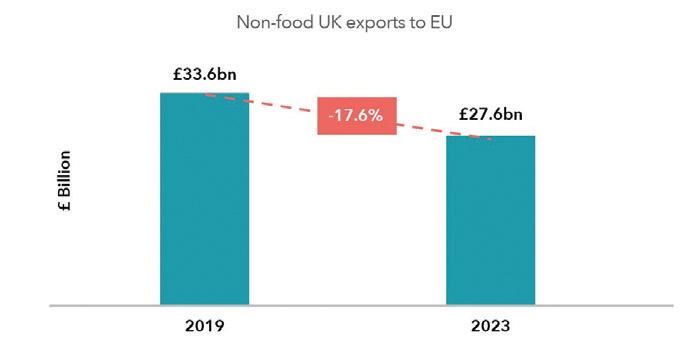
Source: Retail Economics, Tradebyte

Source: Retail Economics, Tradebyte
3: The top 10 markets account for 86% of EU’s £323bn of non-food online sales
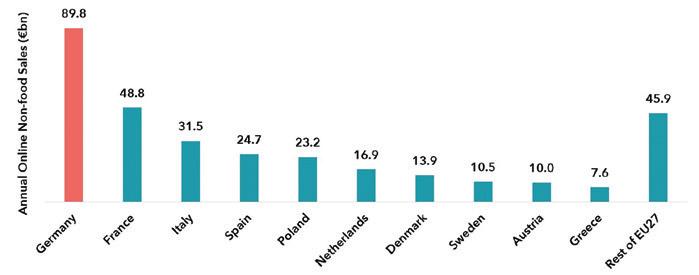
Source: Retail Economics, Tradebyte
brands and retailers looking to sell in Europe post-Brexit. From language barriers to taxation and customs issues through to warehousing and fulfilment, these are not small obstacles to overcome,” said Alexander Otto, Head of Corporate Relations,
Tradebyte. “In today’s marketplace landscape, access to relevant customer data, an intuitive understanding of the market, relevant experience and knowledge of current trends and an effective fulfilment strategy is critical to success.”







Discover the molecules that make life work

